There are plenty of personal branding tips, like:
- “Post five times per day”
- “Post more video content”
- “Post at 8:27AM PST!”
However, I haven’t seen any recent to support many of these claims.
Until now.
I analyzed 100 LinkedIn influencers as well as each influencer’s three top performing posts (for a total of 300 posts) to answer questions like:
- How often do top creators post?
- How many top performing posts are reposts?
- What are the top performing types of posts (image, video, carousels, etc.)?
In this post, I’ll share what I learned from this data and how you can use it to grow on LinkedIn.
About The Data Used To Develop These LinkedIn Personal Branding Stats
First, I acknowledge that 100 LinkedIn profiles and the top three performing posts (for a total of 300 posts) is a very small sample of data.
Unfortunately, LinkedIn has strict limits, making it difficult to scrape a larger sample size.
However, even a small sample of data allows you to see dominant trends.
Therefore, this data isn’t designed to deliver hard and fast rules. Instead, it shed light on several trends that can help you improve your LinkedIn personal branding strategy.
As for the data itself, we only analyzed LinkedIn profiles who:
- Earn at least an average of 40 comments per post
- Post at least 30 times in the past six months
- Have less than 500,000 followers

The minimum requirement of 30 posts in the last six months and less than 500,000 followers helped us eliminate “business celebrities” (i.e., well-known entrepreneurs/executives with thriving personal brands outside of LinkedIn).
These requirements allow the data to illuminate tactics and strategies anyone can use to grow on LinkedIn.
For example, Sam Altman could post anything on LinkedIn, and the post would receive high engagement simply because of his brand outside of LinkedIn. Yet if you copied his exact post format, style, and tone, it probably wouldn’t perform as well simply because he already has a wider network than the average entrepreneur or professional.
I also looked at the three top performing posts from each influencer. We defined “top performing” as the posts with the most engagement in the past six months and ultimately collected a data set of 300 posts.
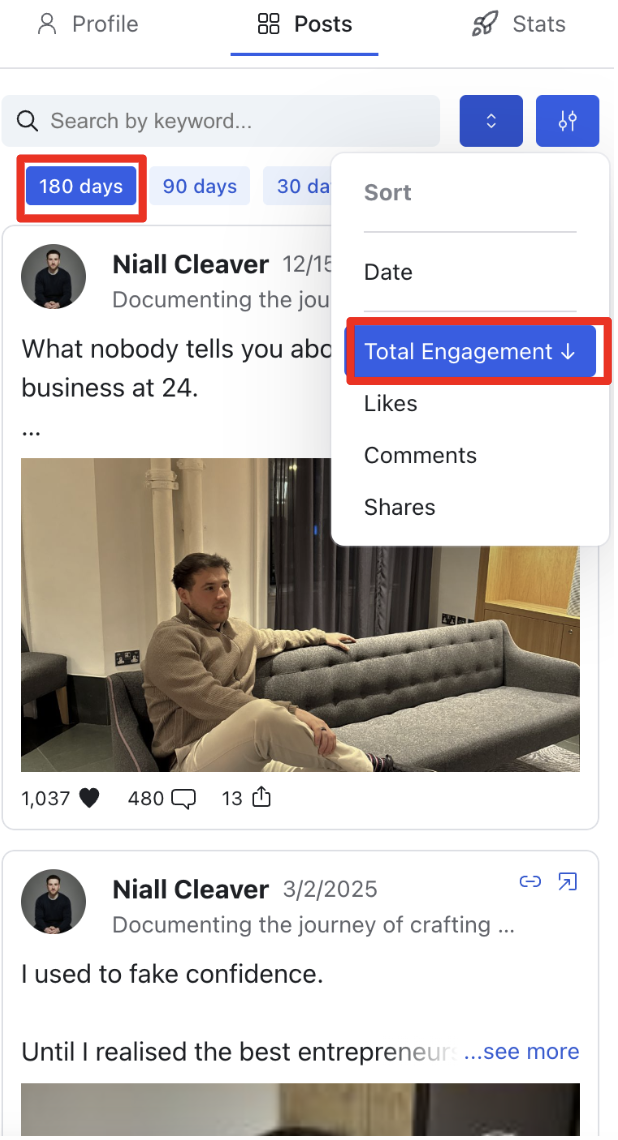
To collect all of this data, we used the Chrome Plugin Creator Match and manually entered the data from each LinkedIn influencer into a spreadsheet.
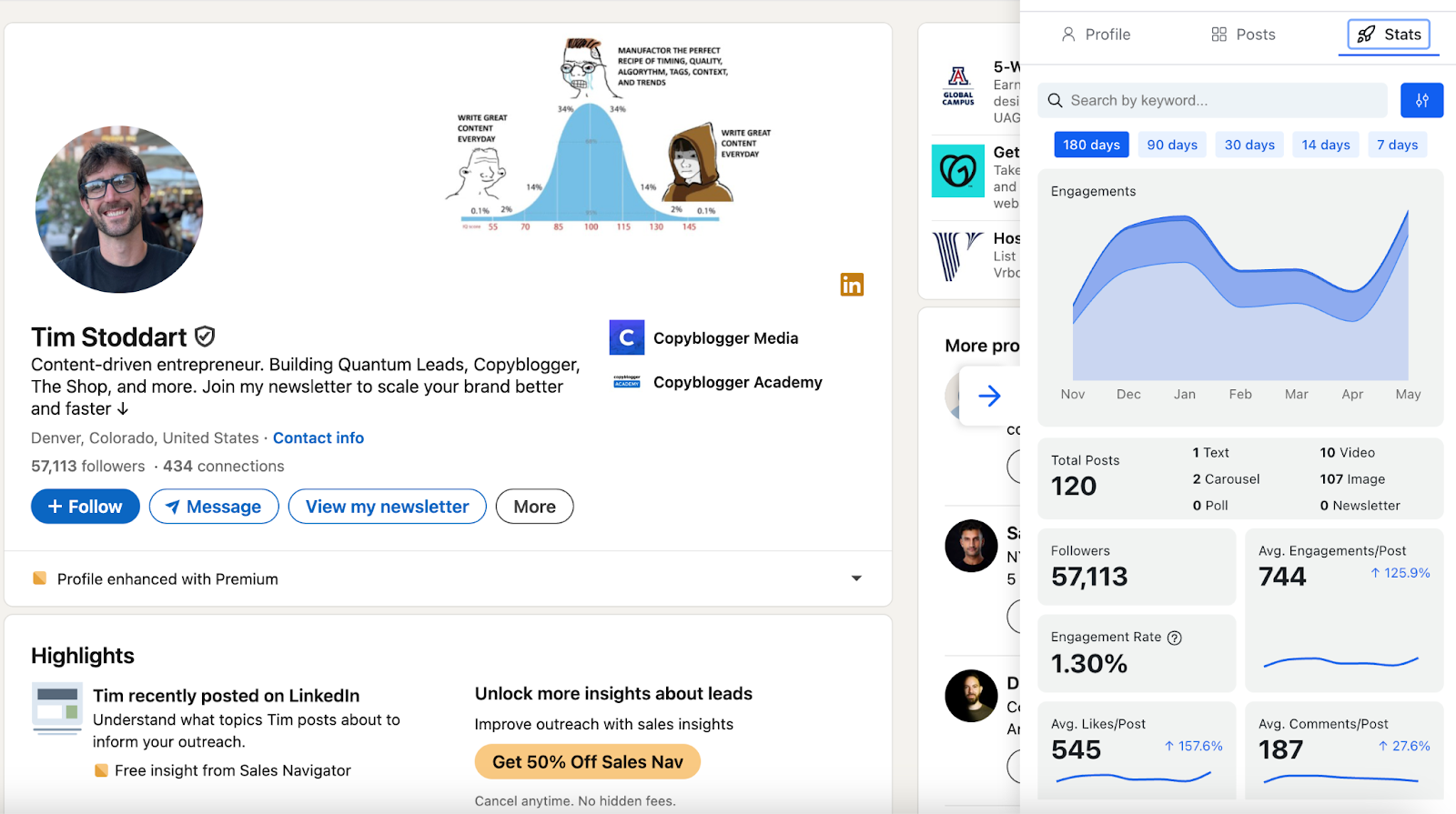
1.) 91% of LinkedIn creators post at least once every three days.
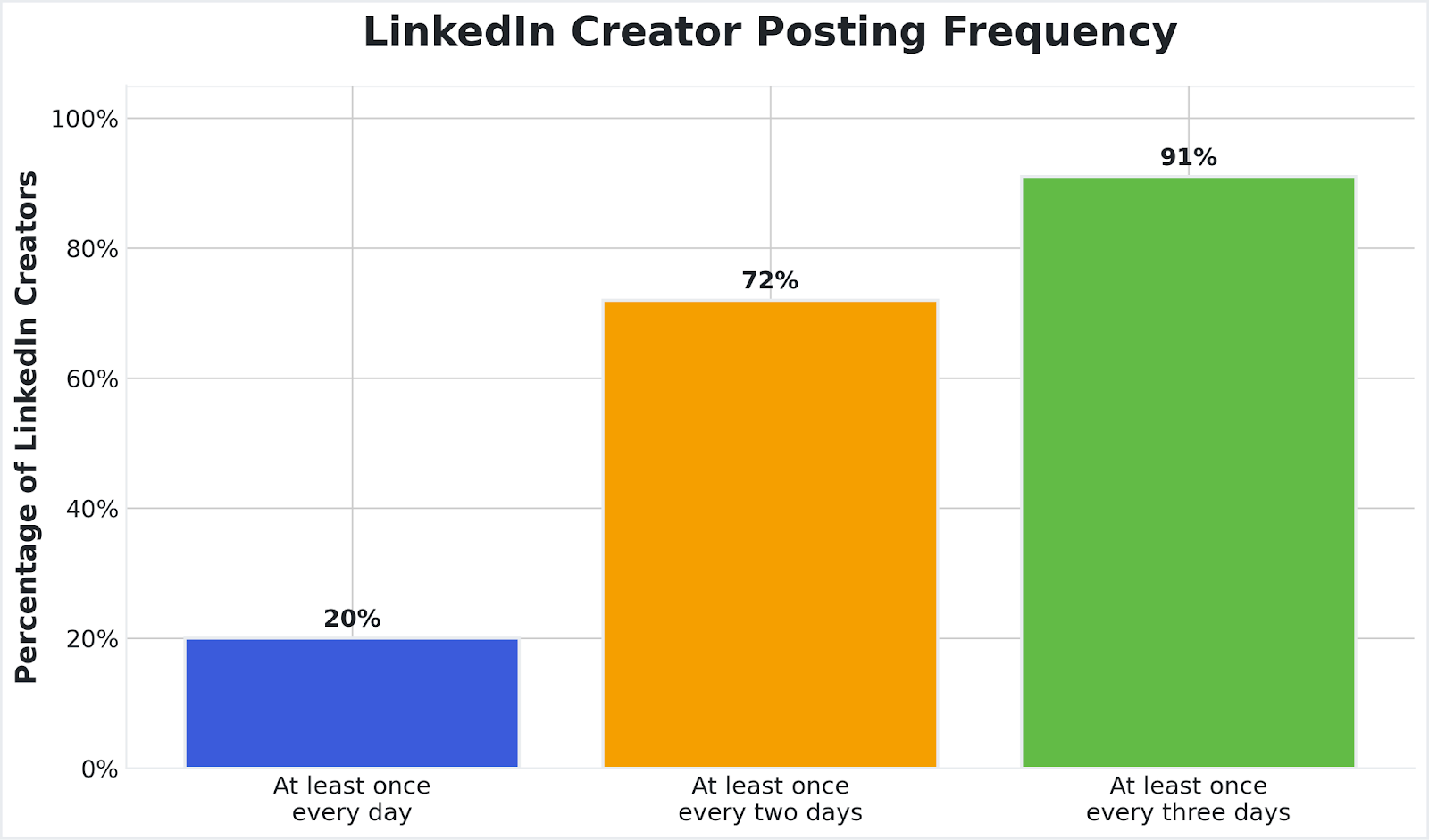
There’s no question that posting frequency is critical.
- 91% of the LinkedIn creators post at least once every three days.
- 72% of LinkedIn creators post at least once every two days.
- 20% of LinkedIn creators post at least once per day.
As mentioned in the data collection method, I only included LinkedIn influencers who had posted at least 30 times within the last 180 days to prevent including “business celebrities” (i.e., people who already had a brand and would, therefore, generate engagement regardless of their LinkedIn savviness.)
However, I was surprised to see that ALL people we included in the study (influencers with a minimum average comment per post of at least 40 and fewer than 500,000 followers) posted at least once every five days.
To be precise, only two of the 100 influencers randomly selected for this study posted less frequently than once every four days.
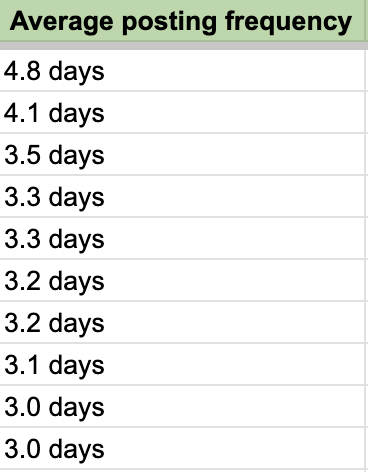
The main takeaway from this statistic is that posting frequently is critical to LinkedIn personal branding success.
Many people agonize over content quality and spend too much time crafting the perfect post when you’d see a better ROI if you frequently post the best content you can produce in a limited time.
So yes, spending hours, days, or weeks on an outstanding piece of evergreen content for a channel like SEO or YouTube might make sense, but for LinkedIn, the key to success is posting frequently.
TL;DR: Just start posting! And post more often!
2.) Over half of the content posted (59%) was image based.
We looked at all of the LinkedIn posts from the 100 influencers included in the study, and the data set ultimately consisted of 12,184 posts.
Images were by far the most popular, as more than half (59%) of posts were image based posts.
Here’s the full breakdown of post types (note that numbers were rounded):
- Text based posts made up 12% of the total
- Video posts made up 11% of the total
- Carousel posts made up 17% of the total
- Image posts made up 59% of the total
- Polls made up >1% of the total
- Newsletters made up 1% of the total
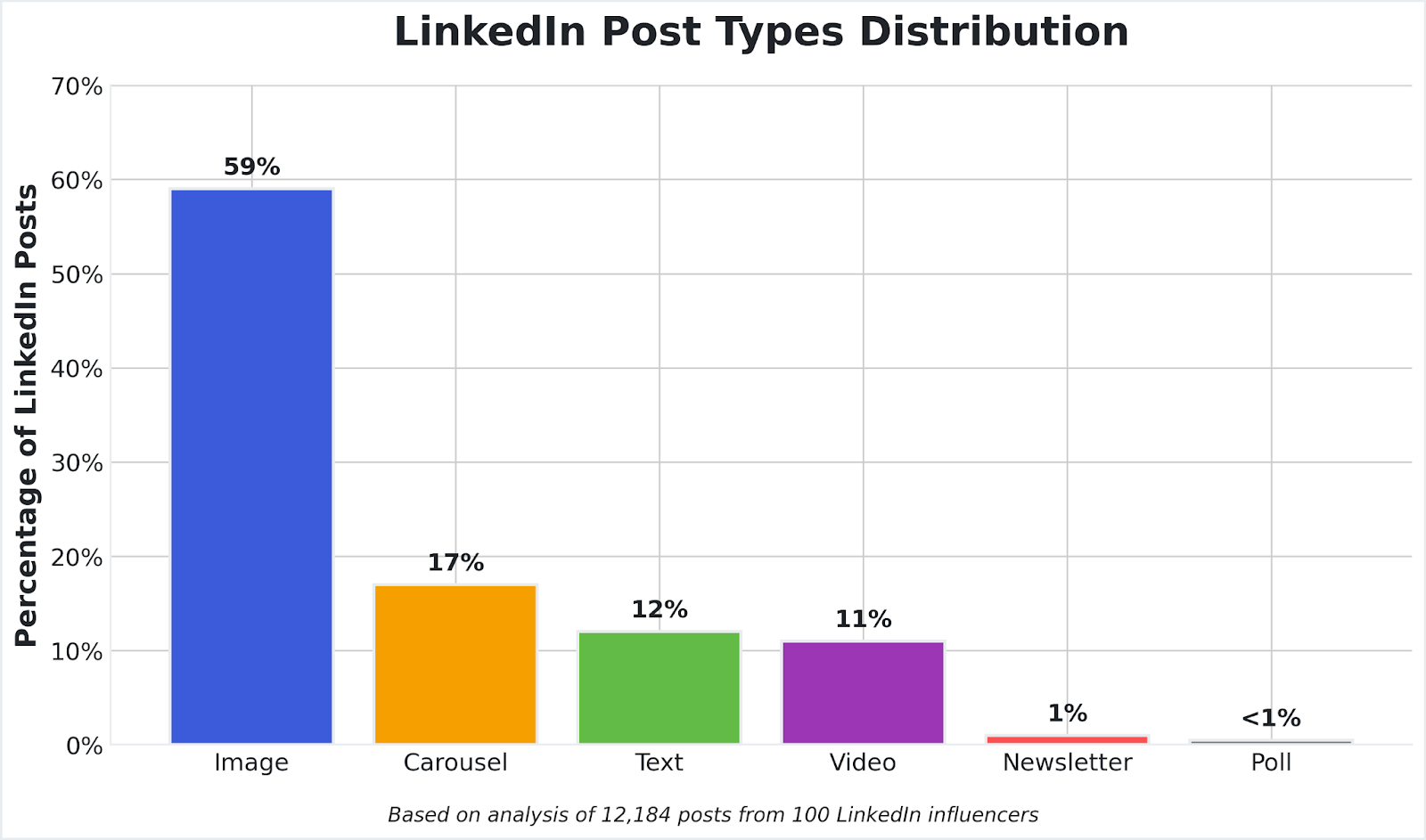
I was surprised that most creators rely heavily on image based posts. Plenty of Linkedin creators encourage video and carousel posts as they may produce higher engagement, yet image posts are the bread and butter for most creators.
I assume this is because, as referenced by the first point, posting frequency is king.
As carousels and videos take more time to create, image based posts are the bread and butter for most creators’ strategy.
Takeaway #3: 67% of the top performing posts were image posts
After seeing that most of the top performing posts were image based, I was curious to see what type of post performed the best.
So we looked at the top three highest-performing posts (defined by “highest engagement” – a combination of the most comments, likes, and shares) from each creator in the past 180 days.
From this pool of 300 top performing posts, we found that image based posts were still the top performers:
- 16% were carousel posts
- 67% were image posts
- 9% were text posts
- 8% were video posts
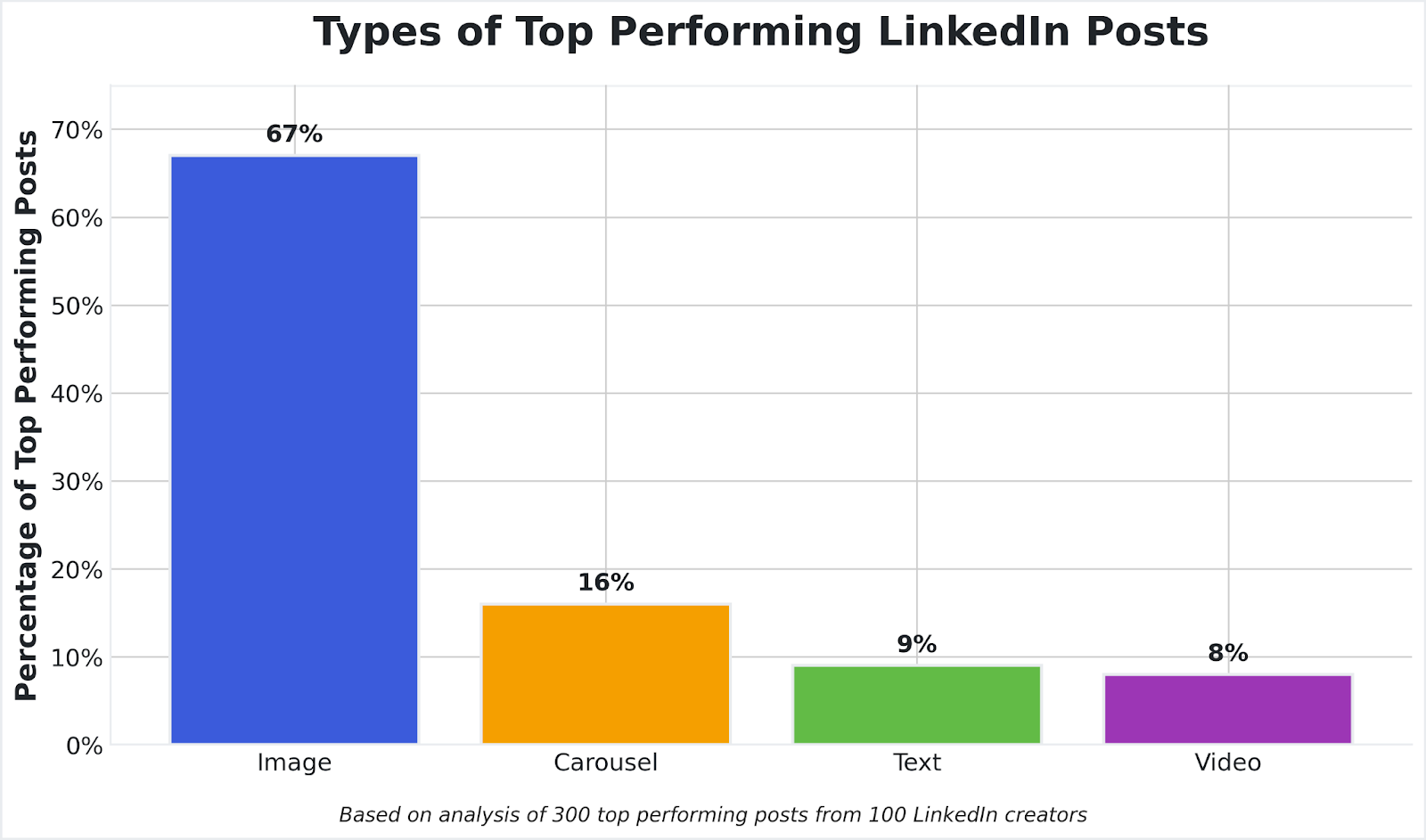
Again, I was a little surprised by this data at first.
I assumed that videos and carousels would be more engaging, and therefore, even if creators didn’t post them as often, they would still be the top performers.
However, there are several other reasons why image based posts still proved to be the top performers:
- The ROI On Luck: Of course, if you have more text based content, there’s a greater chance that one of them will take off. But I think these next factors have more of an impact.
- Content Substance Trumps Content Medium: It’s easy to fixate on the content medium rather than the substance of the content itself. But if you just cured cancer and explained how you did it, that content would perform well, regardless of whether you chose to make a video, a carousel, a graphic, or a text-based post. Focus on improving the substance of your content rather than fixating on hacks or mediums.
- Instant Comprehension: A graphic can display a concept more instantaneously, whereas videos and even carousels require more time for people to get into the content and “get the point.” Especially on social media, instant comprehension is critical for comprehension.
If you’re curious to see how the top performing posts compared to the total posts, here’s a breakdown:
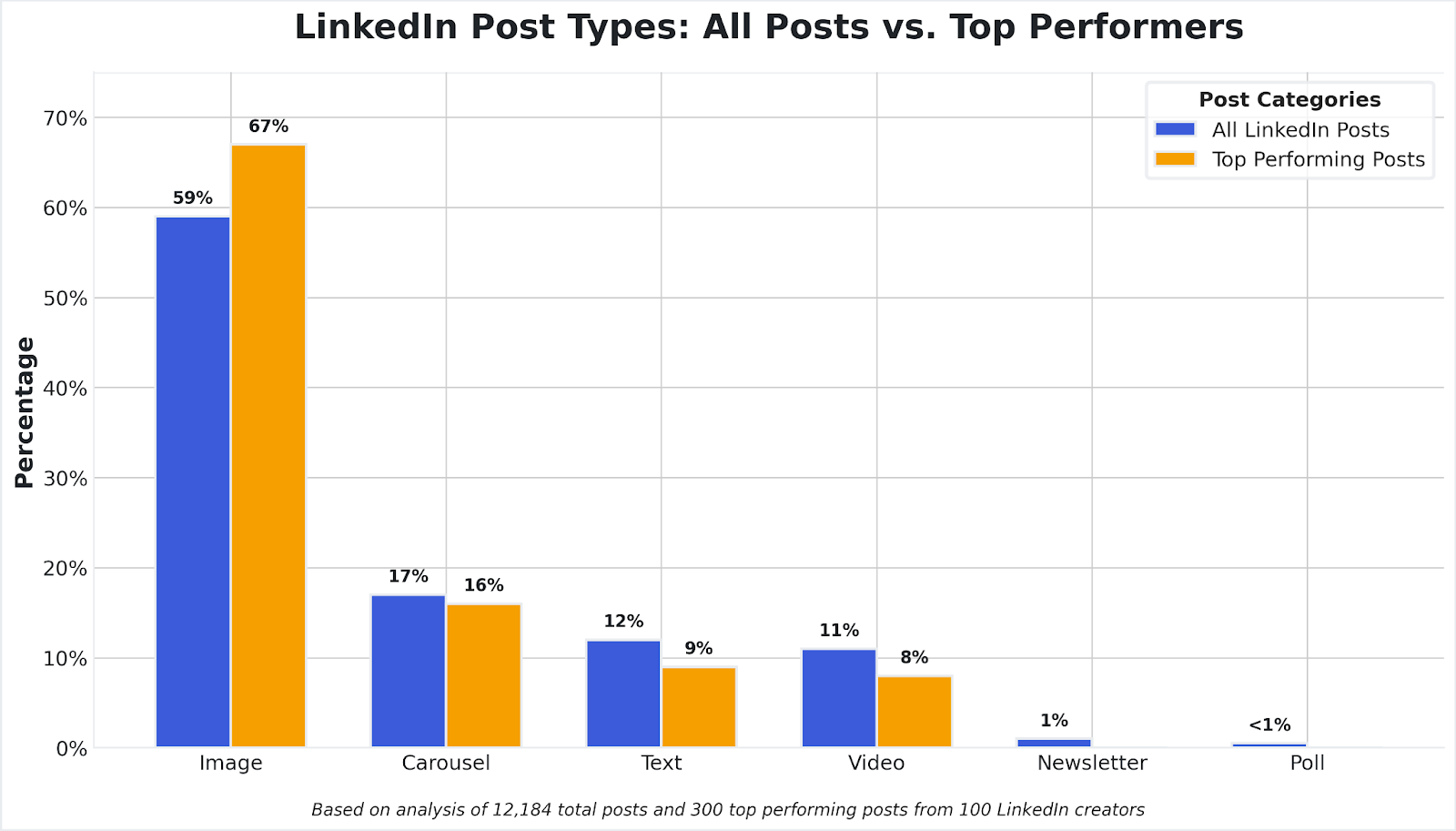
Takeaway #4: 16% of the posts that had an image or video were not original

Many people don’t post on LinkedIn because they don’t want to hire a designer or create their own videos.
However, it turns out that you don’t need to create unique graphics or videos.
The data shows that 16% of the top performing image and video posts were graphics or videos that the creator borrowed (with permission) from another creator.
Here’s a great example of how Reno Perry used (and then credited) a graphic from another creator to make his post more engaging:
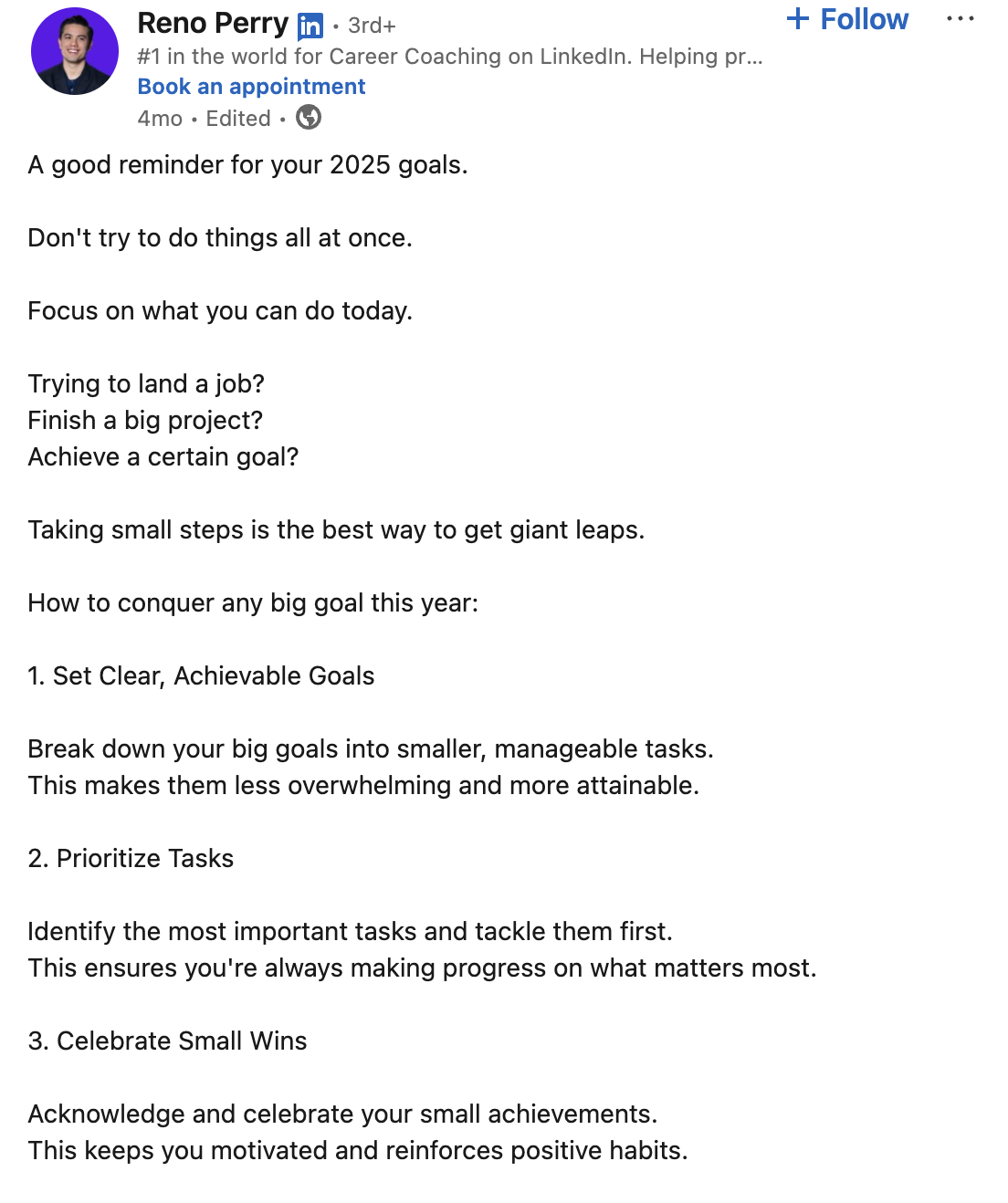
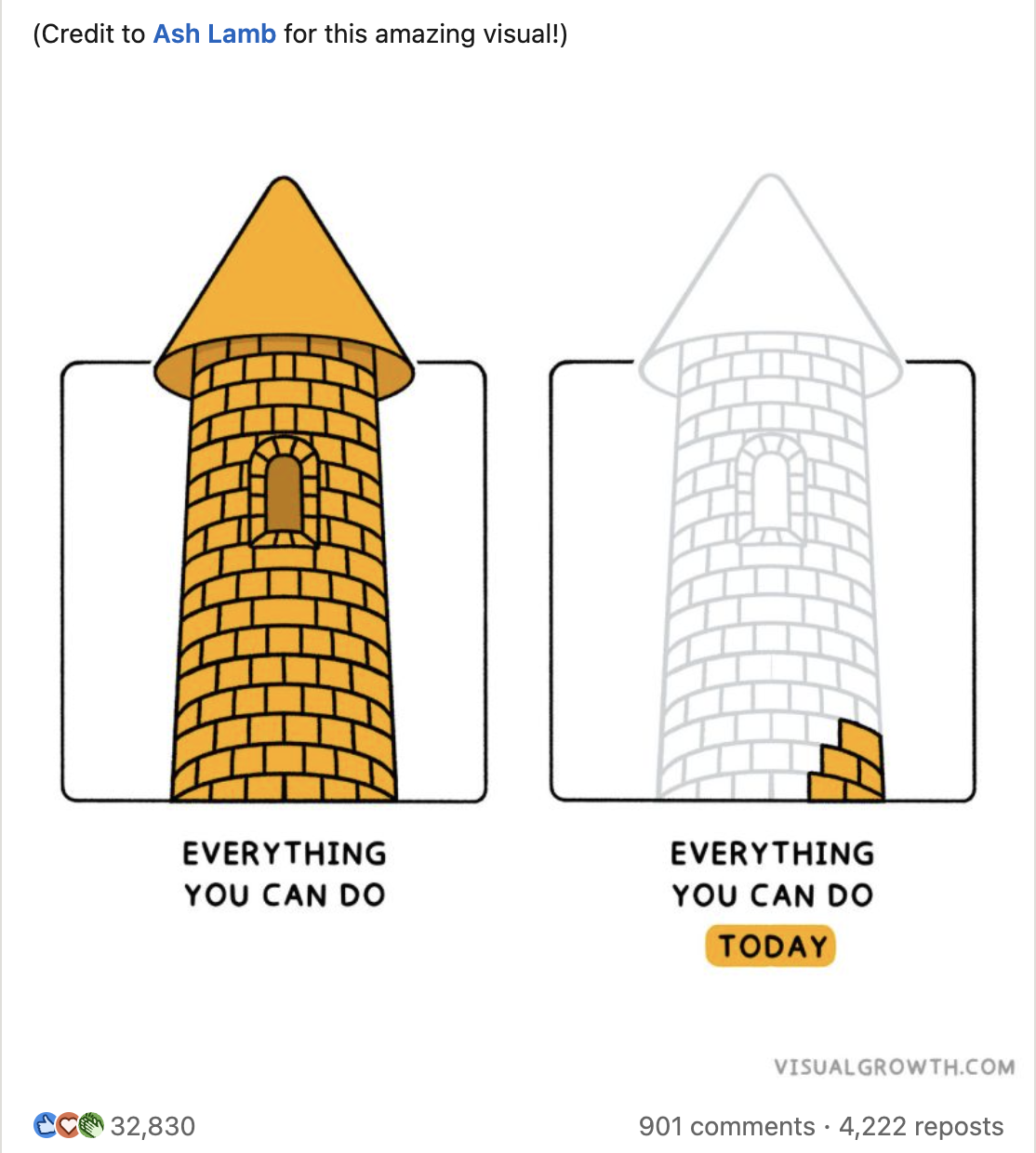
In some cases, you can even piggyback off someone else’s entire idea and creative (as long as you credit them).
Here’s a great example of this strategy from Kyle Poyar:
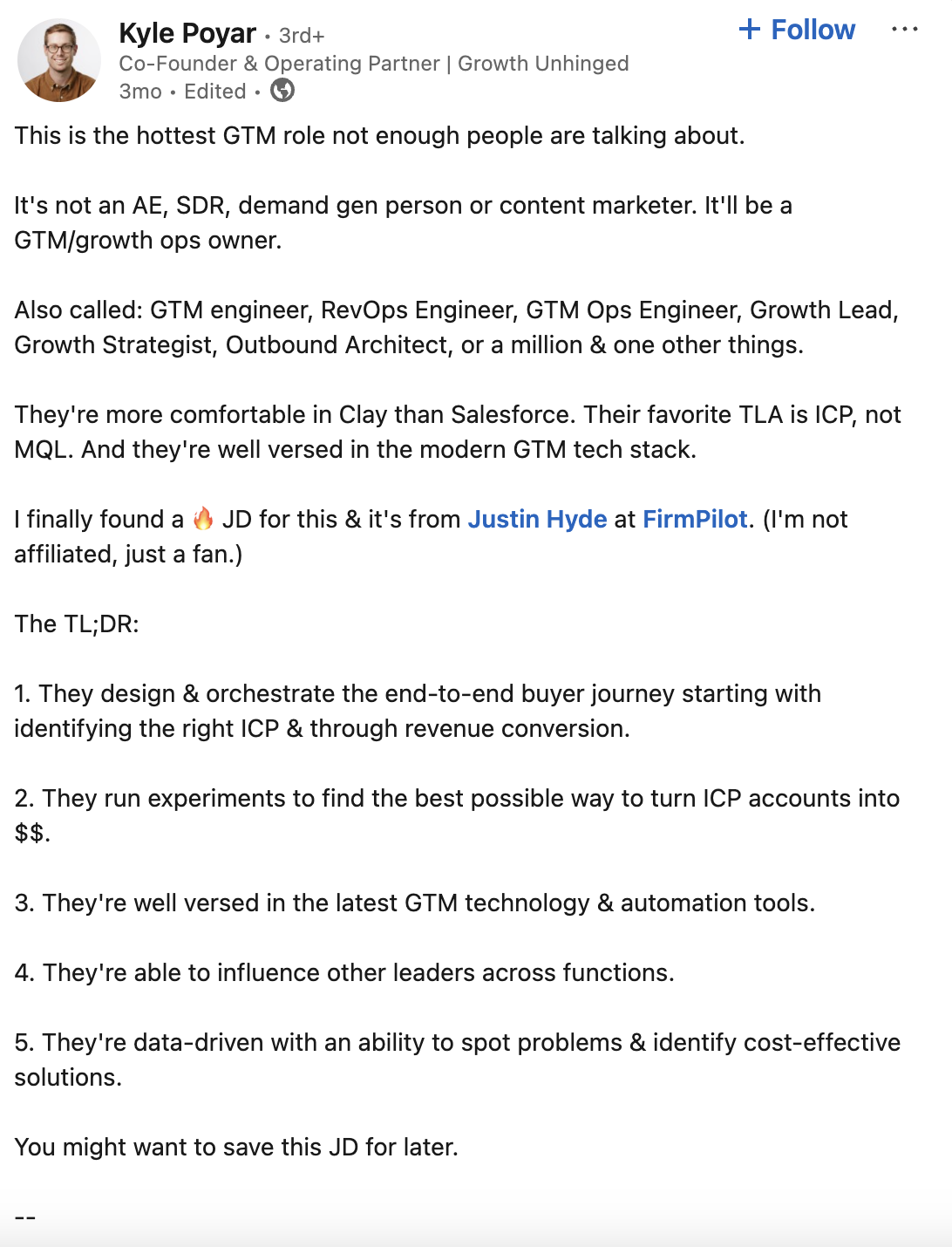
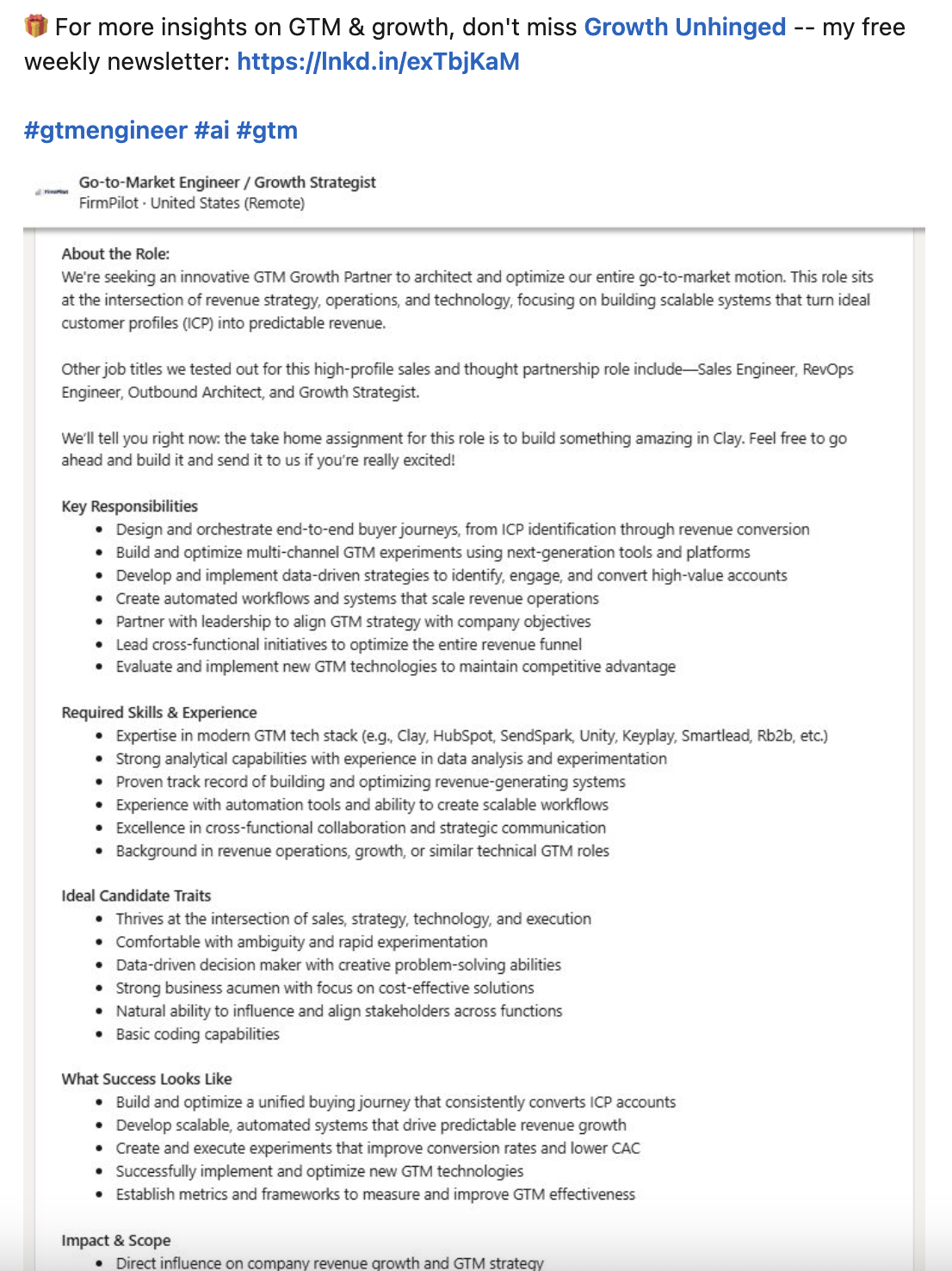
We already established that publishing frequency is one of the most important indicators of success on LinkedIn, so if you’re in a pinch and need to come up with something quickly, consider borrowing another creator’s graphic or video and give them credit.
Many of these creators actually appreciate that you share their content, and it can be a great way to build more relationships.
Takeaway #5: 37% of the top performing image based posts were professionally designed graphics
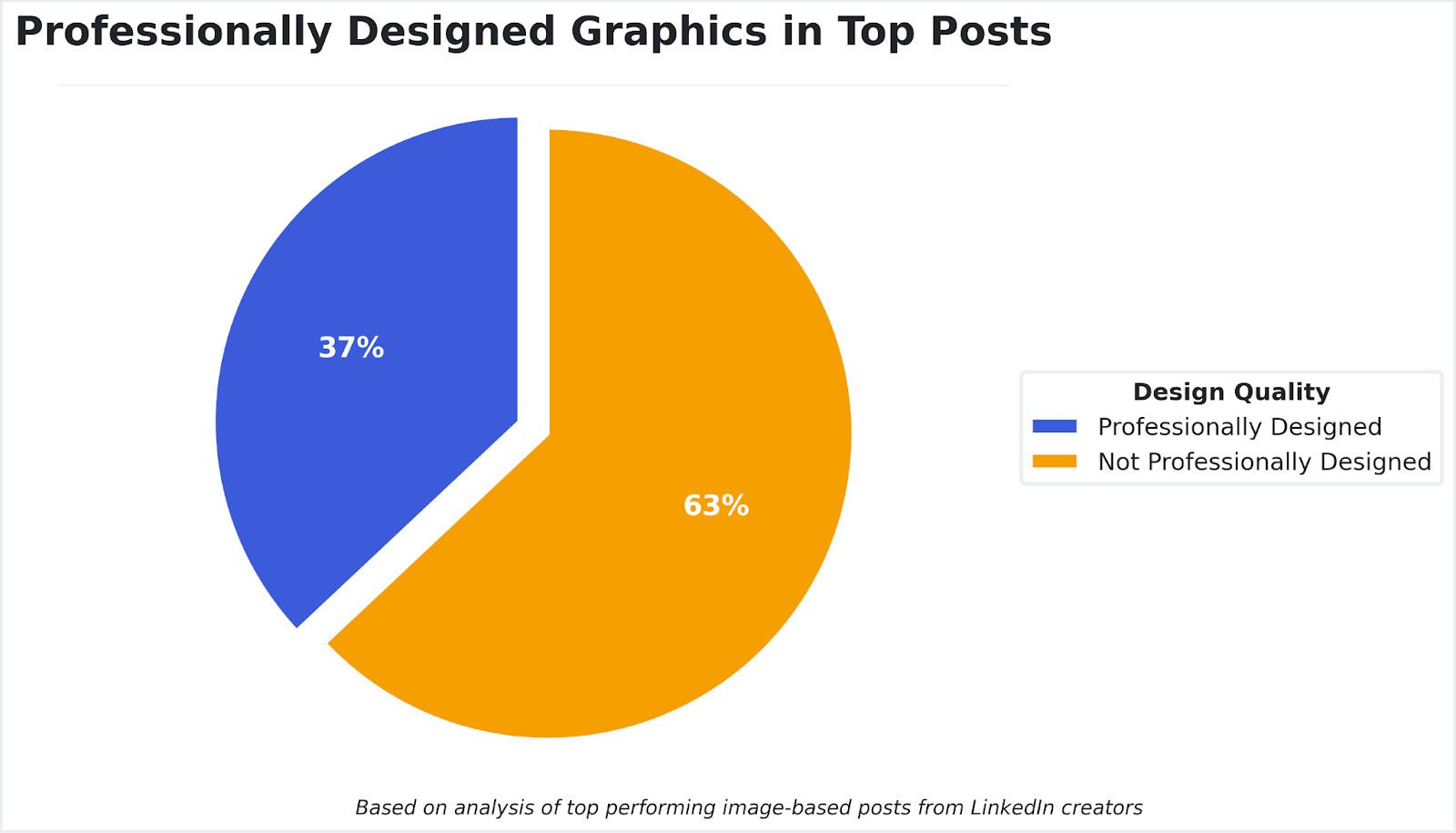
I expected most of the top performing image posts to be high quality, professionally designed graphics, though I found that most of them were just cell phone pictures of the creator.
For example, this was the image for one of this creator’s top performing posts.
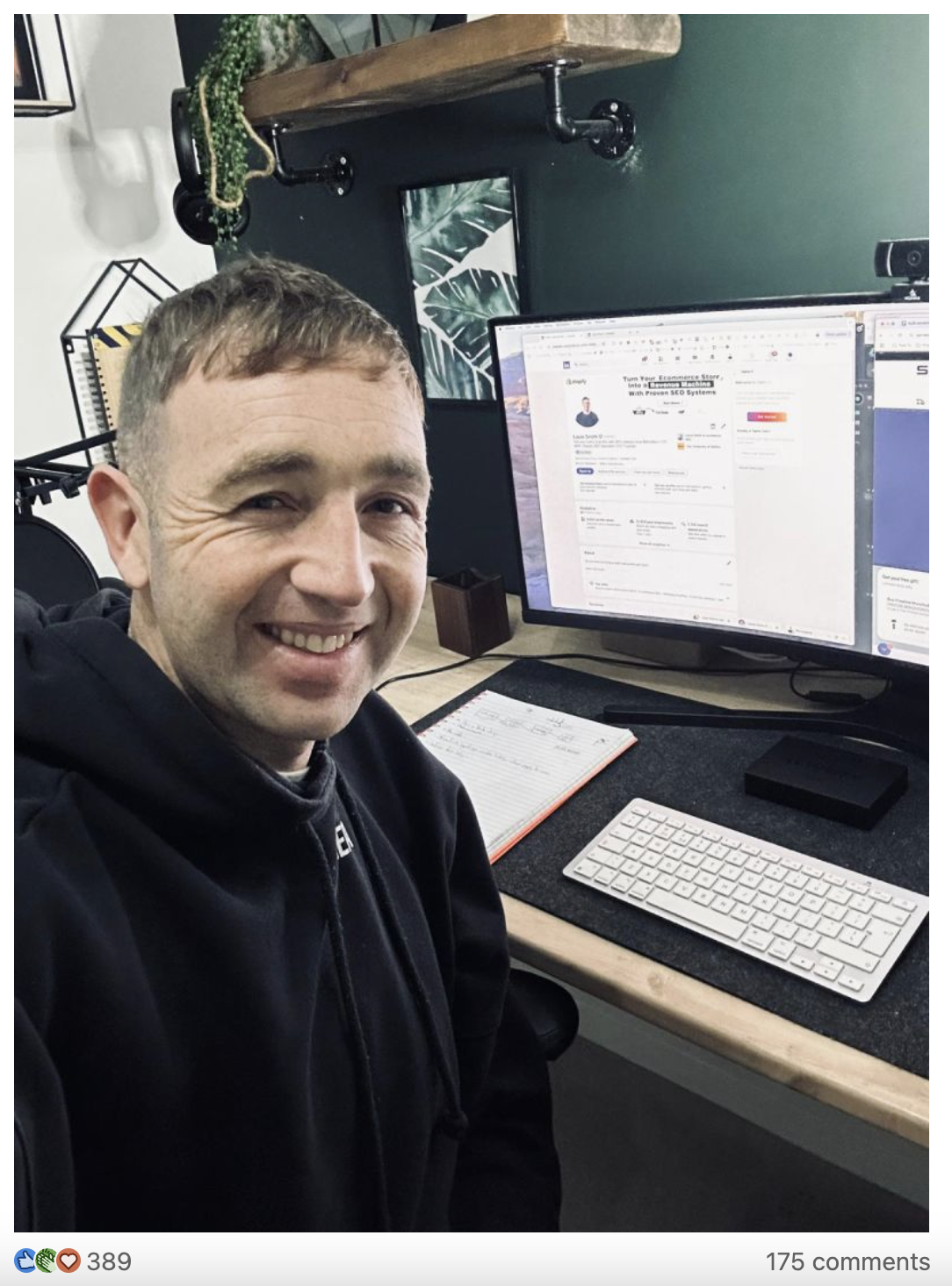
Remember that LinkedIn is first and foremost a social media platform, so posting life updates and including pictures of yourself is a great way to increase engagement.
That said, the quality of engagement might be higher if you post graphics illustrating blueprints or tips as that will attract your ideal audience, though personal photos can also help build trust with your audience.
Takeaway #6: 17% of the top performing posts were reposts
When I started combing through the data, I realized many of the three top performing posts were reposts. Here’s an example:
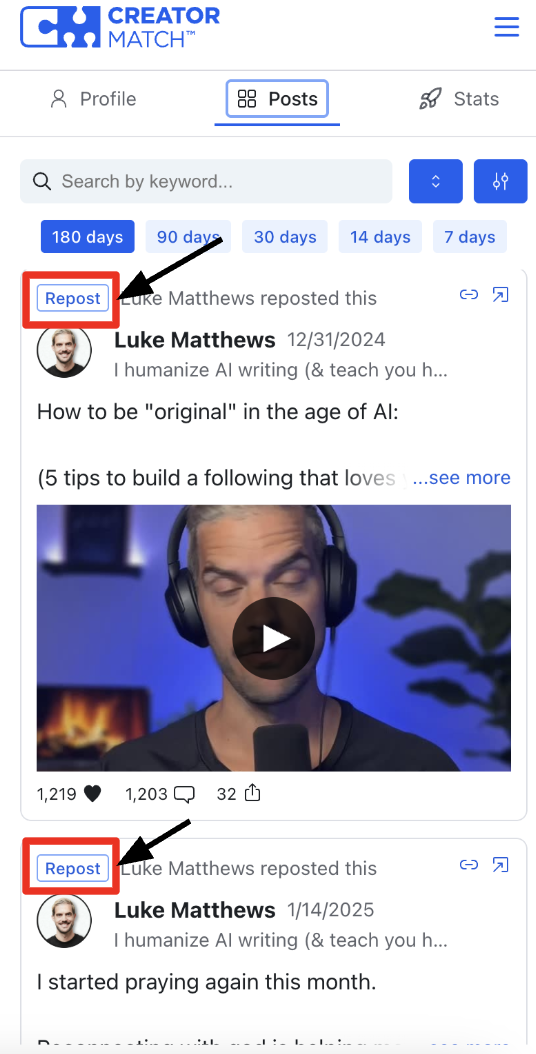
Therefore, I excluded any reposts from the main data set of 300 posts for the sake of analyzing what makes a post an outlier, but we later went back and looked at just how many of the top three posts for any given creator were reposts.
And the answer was 17%.
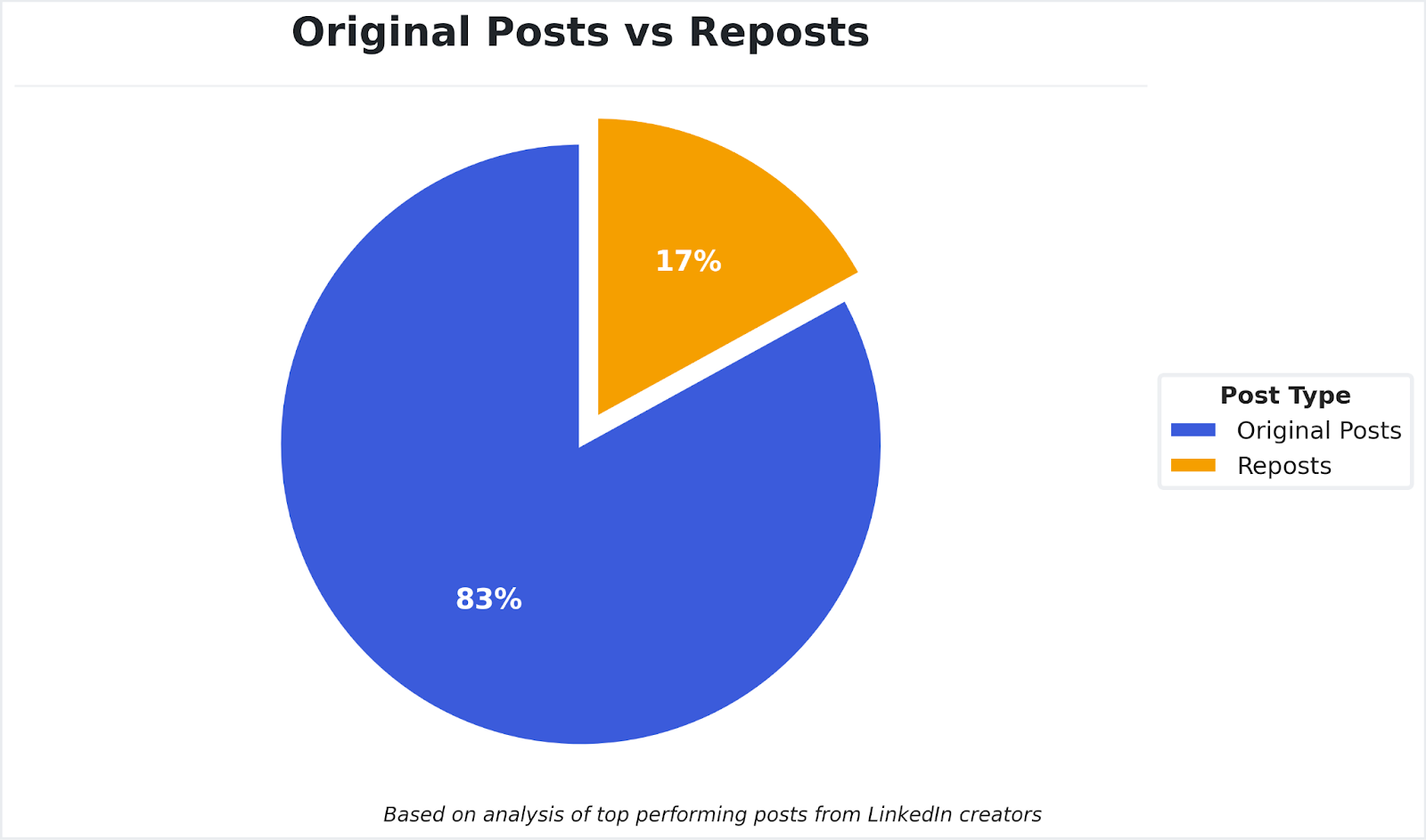
The takeaway is to periodically repost each of your top performing posts.
In fact, the reposted content often outperformed the original version.
This may be because the creator had more followers when the reposted version was published.
However, it still shows that most of your followers may not see (or remember) your content, so there’s a significant benefit in reposting your old content.
Here’s a full breakdown of the repost statistics:
- 17% of the top performing posts were reposts
- A repost was among the top 3 performing posts for 36% of the profiles analyzed.
- Over half of the reposts (67%) actually outperformed the original post.
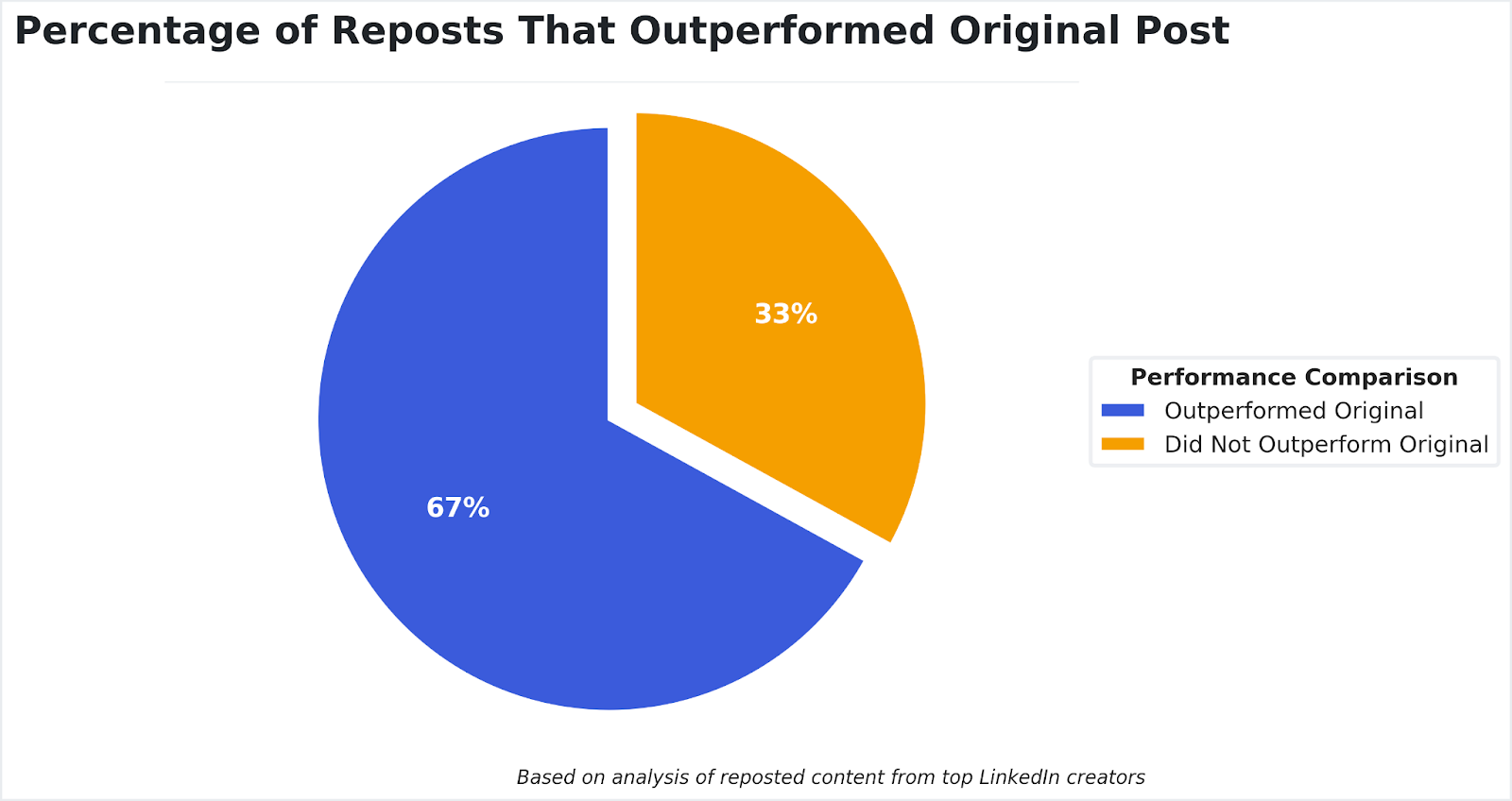
Takeaway #7: Engagement dramatically decreases as your follower count increases
Here’s the breakdown of average engagement rates at different follower counts:
- 0.51% is the average engagement rate for influencers with 200,000 to 500,000 followers
- 0.91% is the average engagement rate for influencers with 100,000 to 200,000 followers
- 0.92% is the average engagement rate for influencers with 50,000 to 100,000 followers
- 1.38% is the average engagement rate for influencers with under 50,000 followers
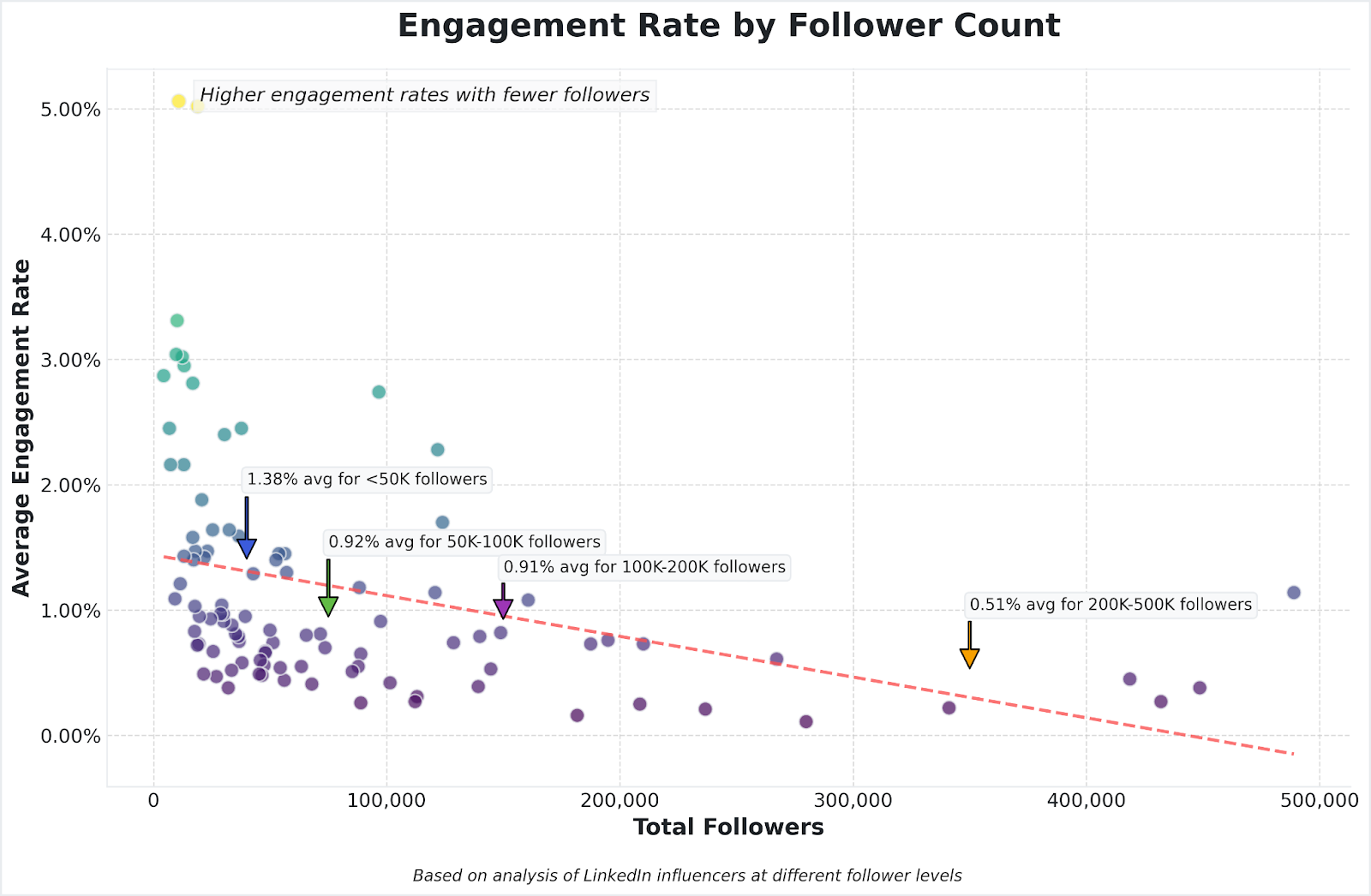
This statistic was a surprise, but it reinforces the point above, which is that it’s essential to repost your content as your follower count grows, because most of your followers probably don’t see all of your content.
This statistic also reinforces the importance of growing a newsletter, as email is one of the few channels where you own the audience and can be sure that each subscriber sees your audience.
Takeaway #8: 8AM PDT or 11AM EST is the most common publishing time
The most common publishing hour is 8AM PDT or 11AM EST.
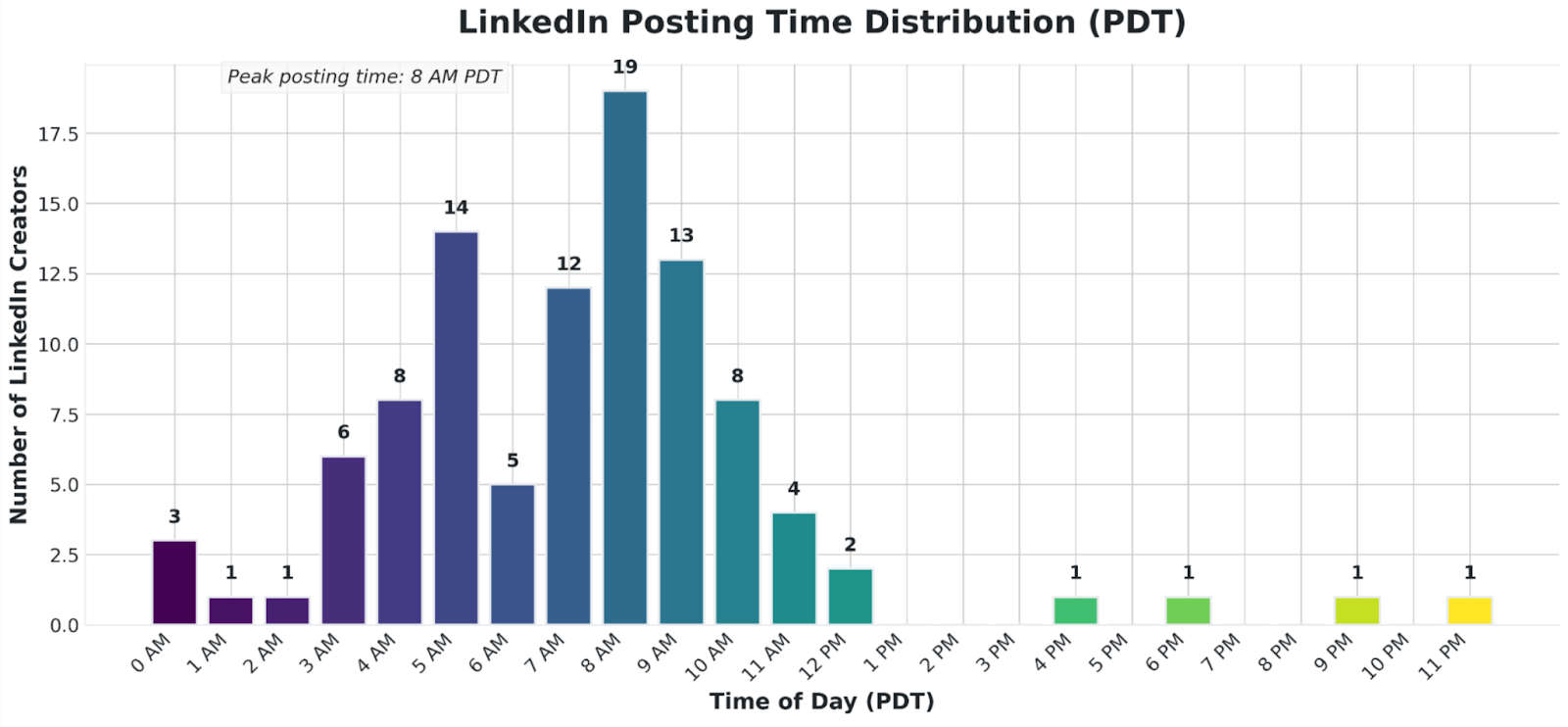
I didn’t collect specific location data on these LinkedIn influencers, though it was an international sample, and anecdotally, I noticed that most of them were in the United States.
Takeaway #9: Only 17% of top performing posts tag other LinkedIn creators/companies
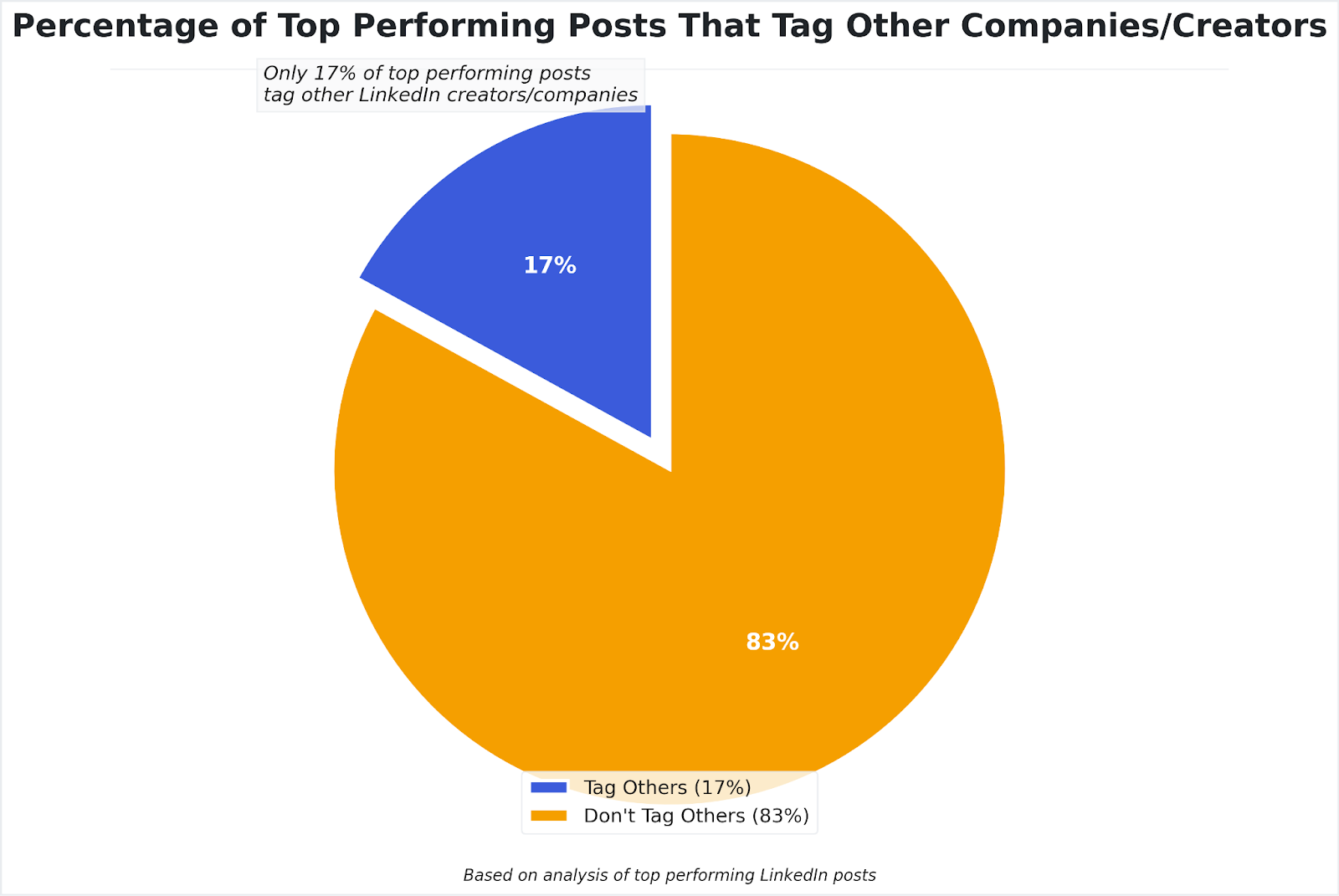
Tagging other people and collaborating can be a great way to encourage engagement.
This post referenced data created by Rand Fishkin and illustrated how he leveraged the data to improve his process is a brilliant example of how you can include other influencers in your content.
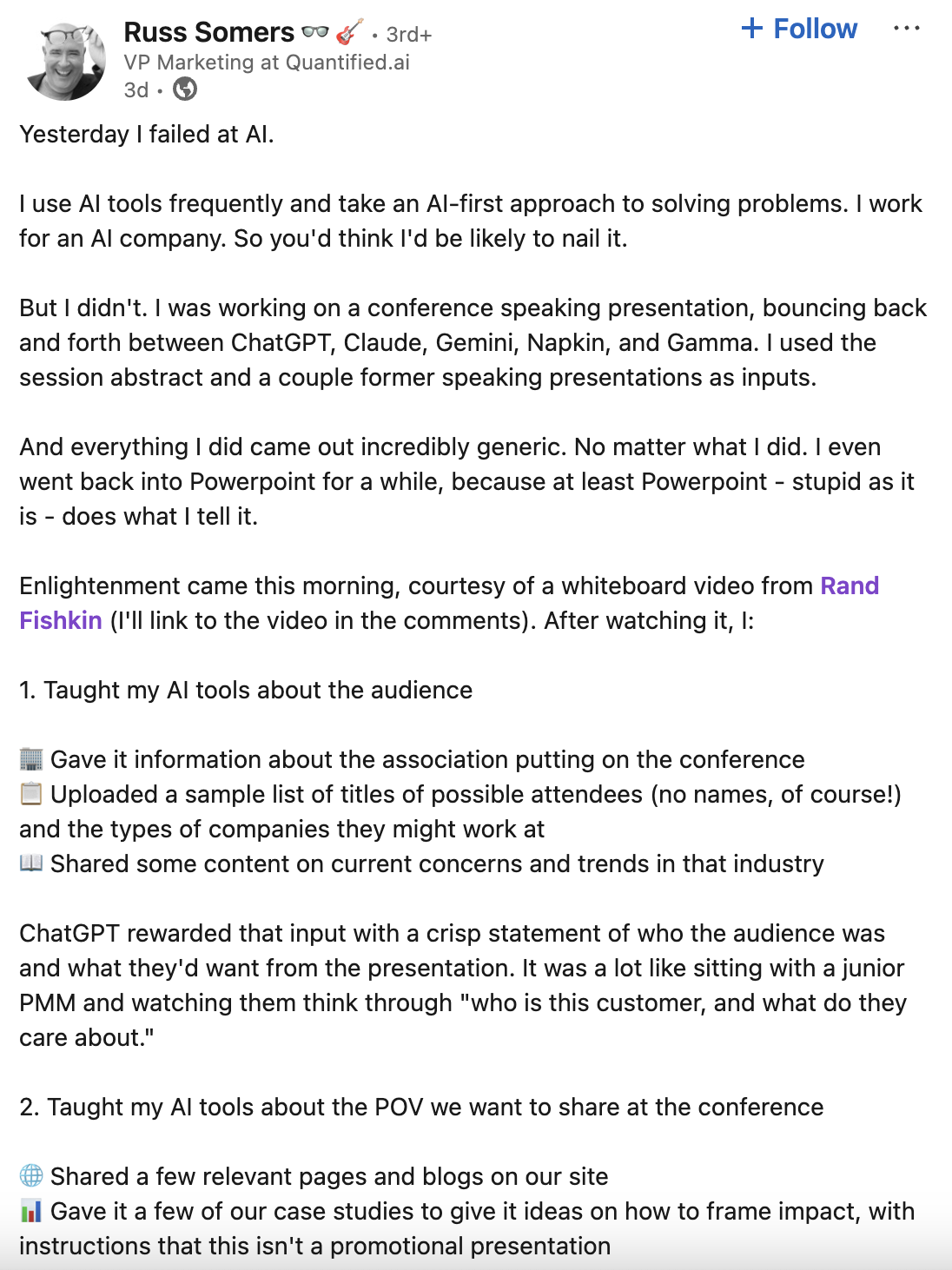
As a result, Rand commented on the post and it organically earned more reach.
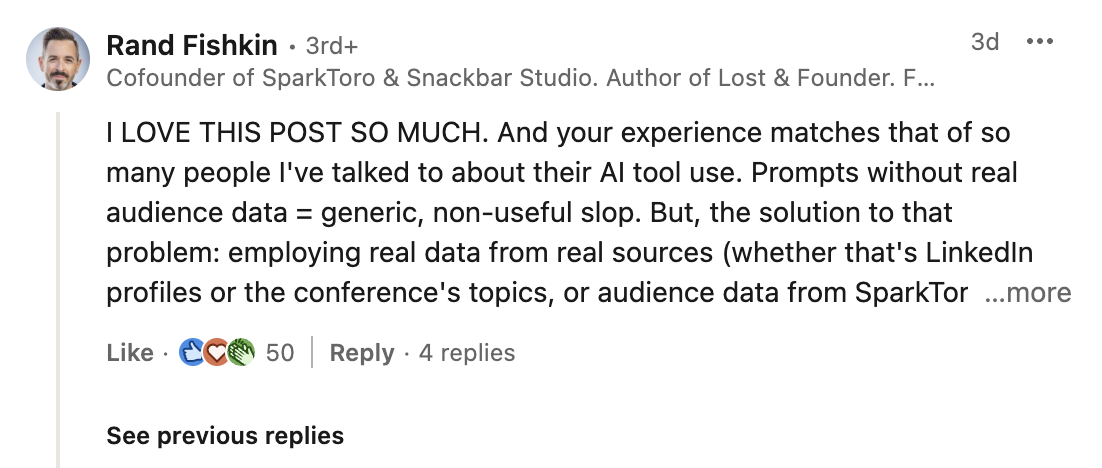
However, this statistic is a good reminder that while many of these common LinkedIn tips (i.e., tagging influencers) can help you increase reach, you can waste time overoptimizing your content when you’d see a better ROI simply posting more frequently.
I also want to note that the maximum number of people tagged in a single piece of content was no more than two.
I found this surprising as I assumed that roundup posts, like the one below, would generate more engagement.
However, the takeaway is that quality content and organic relationships trump “engagement strategies.”
Takeaway #10: 88% of Top Performing Posts Had Zero Hashtags
LinkedIn hashtags seem to be less important (or simply less utilized), as 88% of the posts did not contain any hashtags.
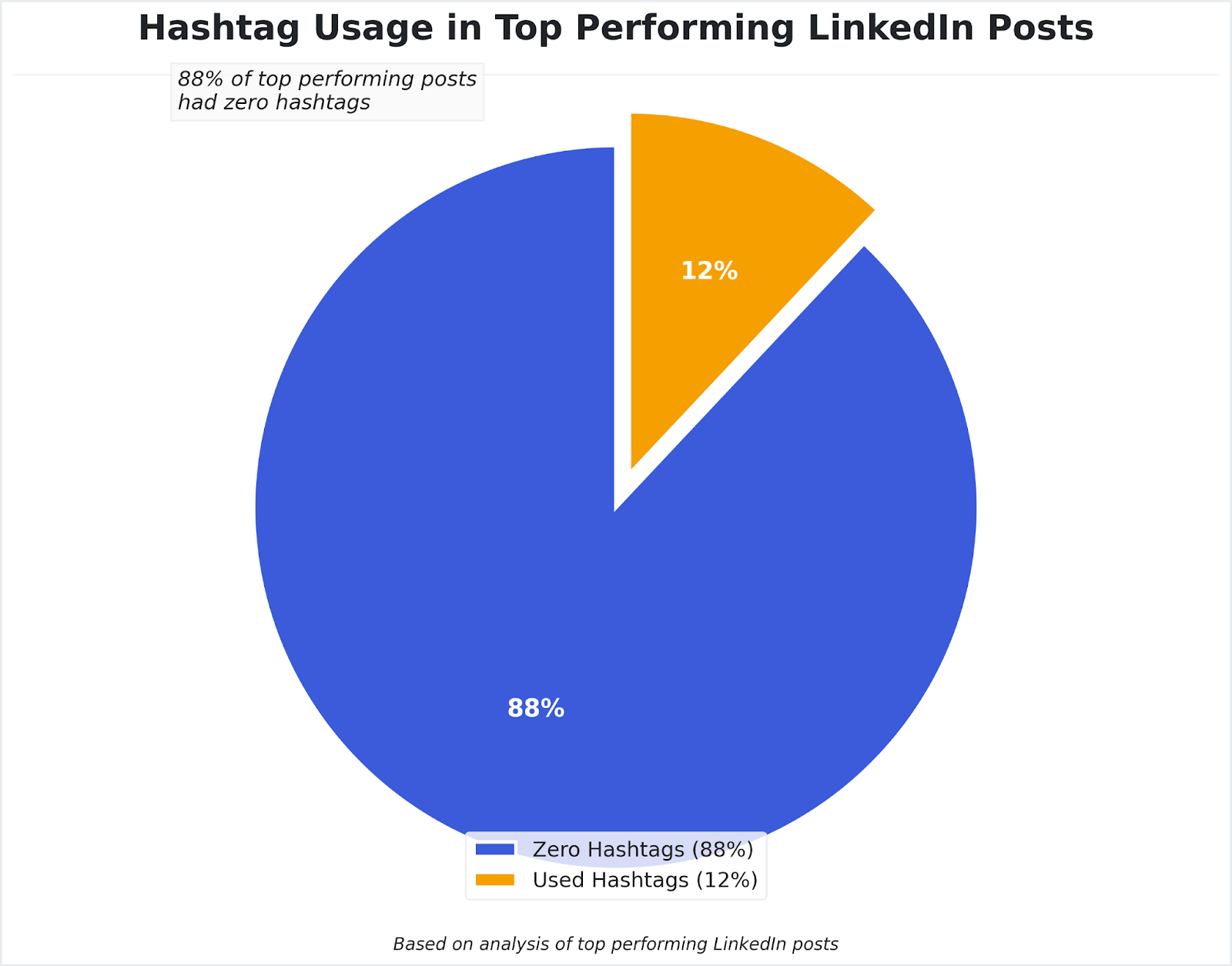
And, even when people did add hashtags, most only used one hashtag.
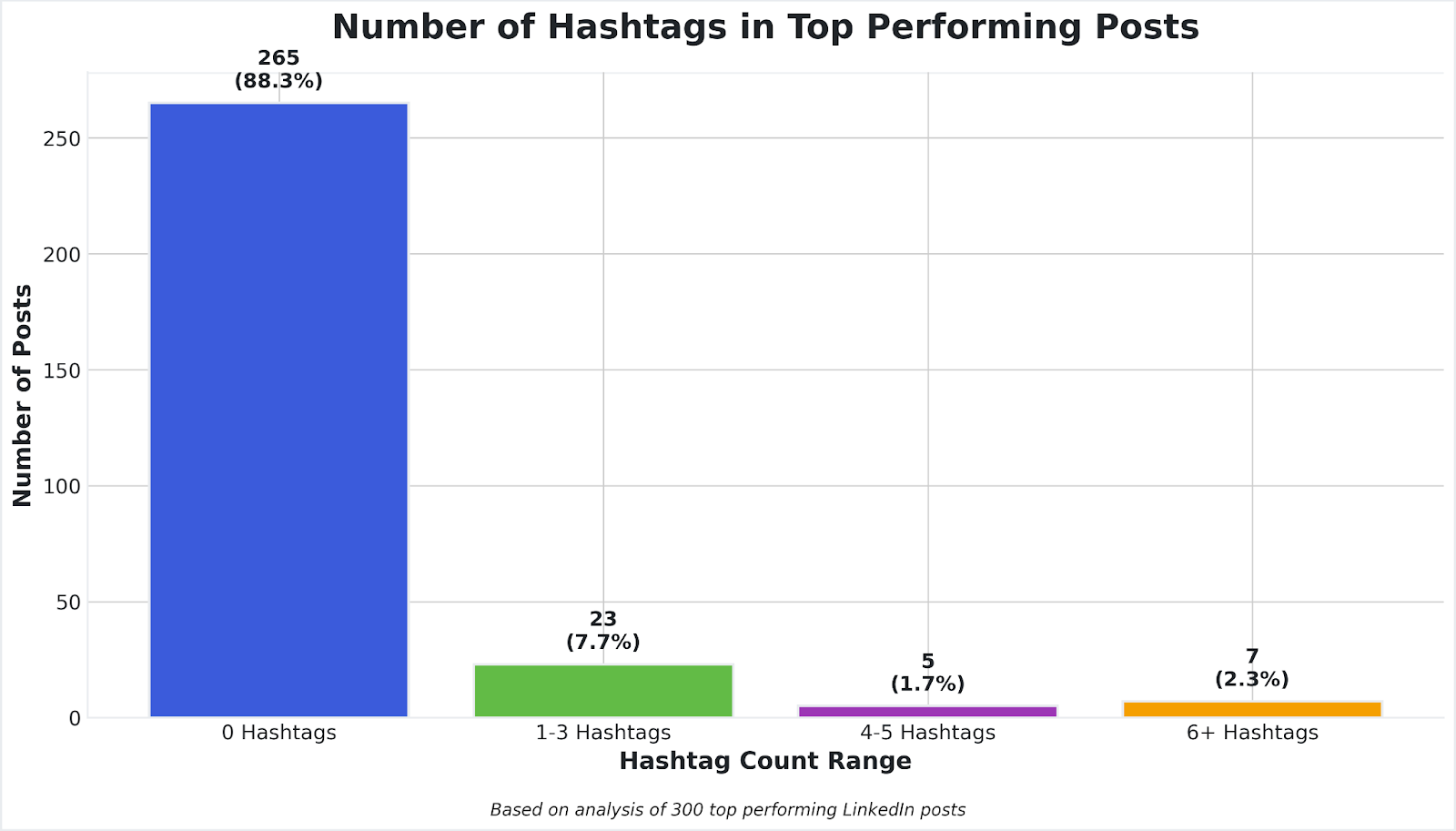
Of the posts containing hashtags, only 34% had more than three hashtags, and only 20% had more than five.
So use hashtags sparingly. And, they likely aren’t as important as they once were.
Takeaway #11: 14% of the top performing posts contained a gated offer
You’ll often see gated LinkedIn posts where people must comment to receive a free resource.
Here’s an example:
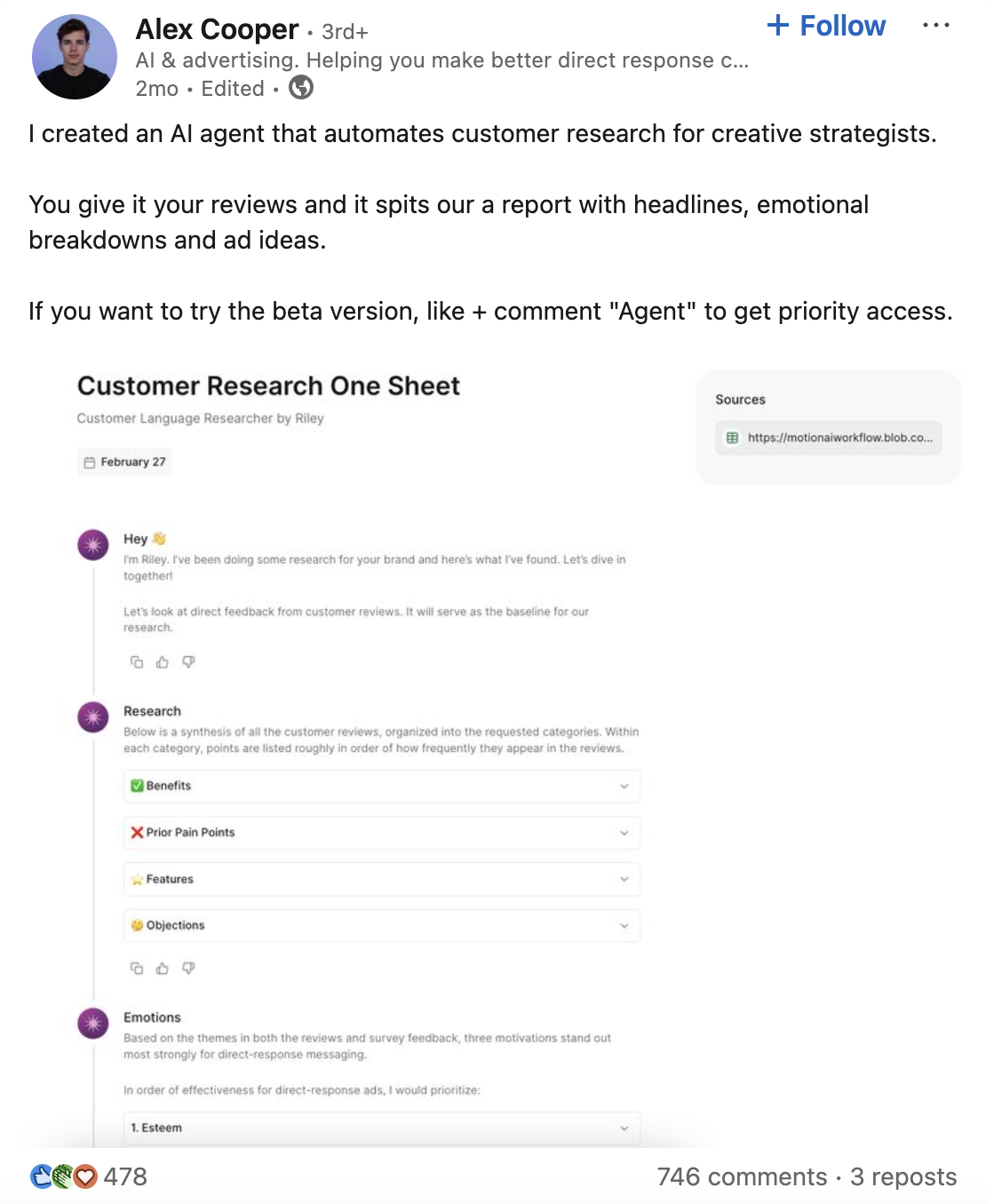
Therefore, I expected these gated posts to make up a large percentage of the top performing posts.
However, only 14% of the top performing posts were gated.
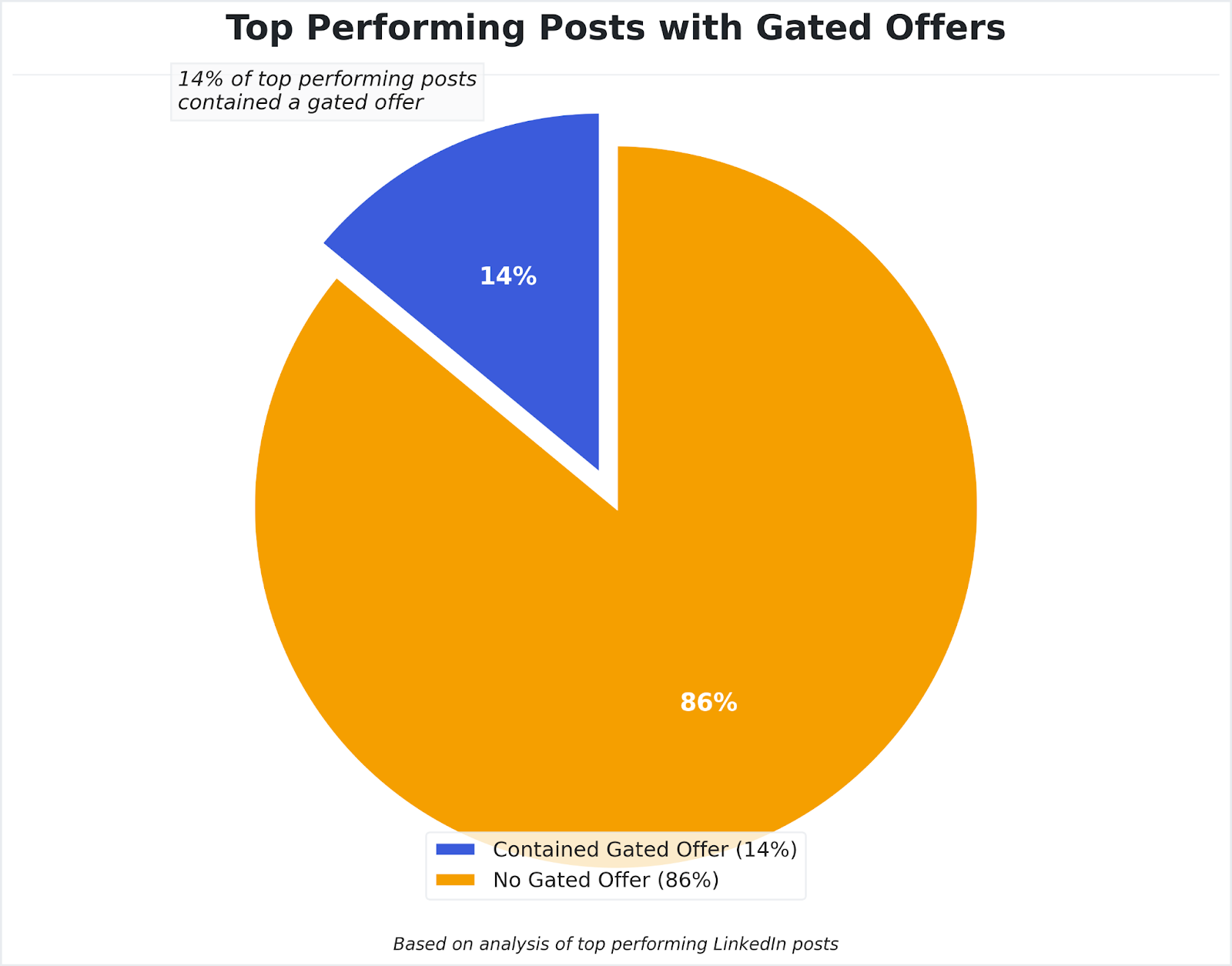
Gating posts can help you build a list but use it sparingly.
If you gate your content, try to capture the person’s email address.
The LinkedIn algorithm controls who sees your content, and it can ban you at any moment. However, capturing emails lets you own your audience and you can ensure each follower receives your content.
Takeaway #12: 18% of top performing posts contained external links
Some social media platforms decrease reach if you include a link in the post, though we noticed that 18% of the 300 top-performing posts contained external links.
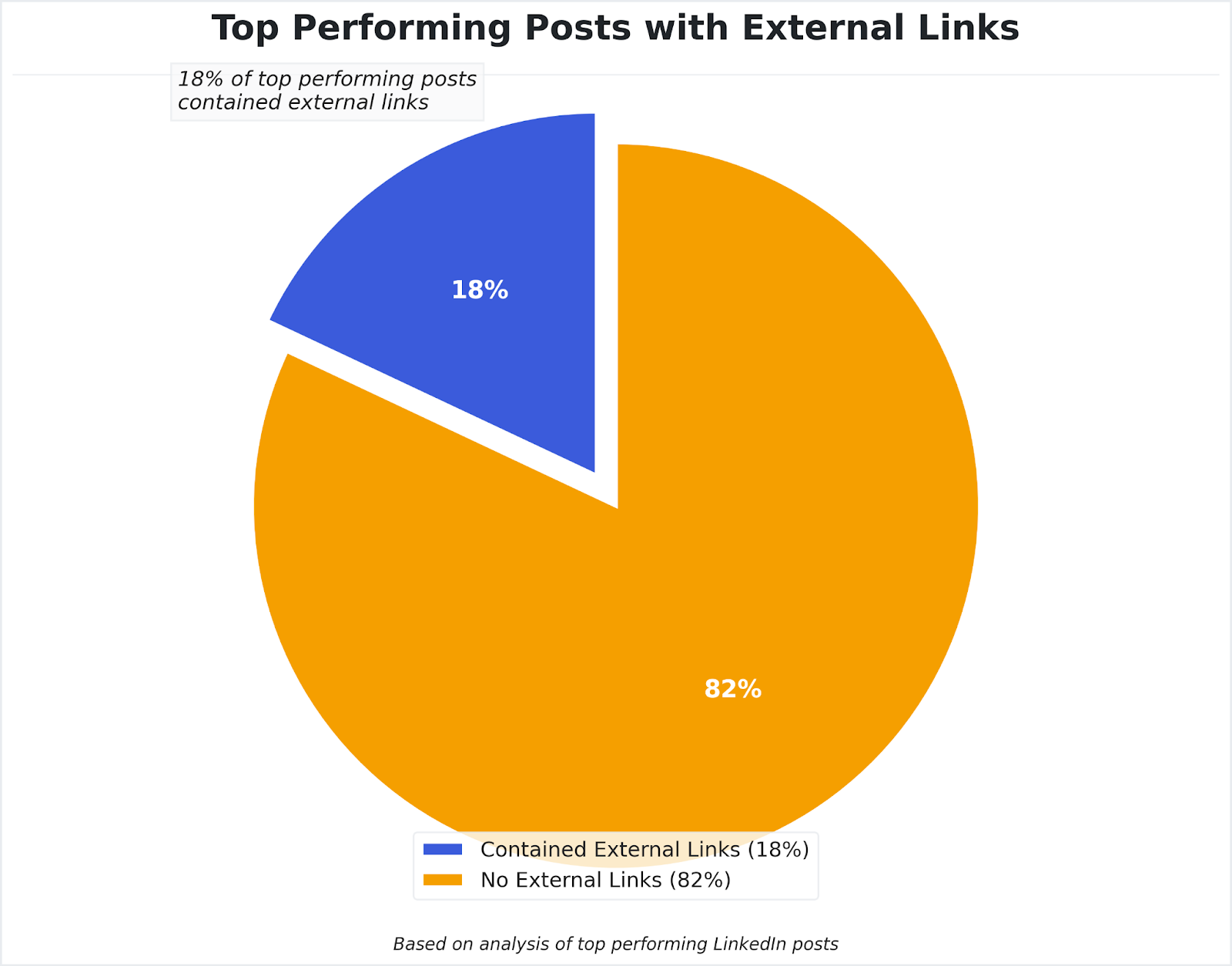
So, your posts can still perform well if you include external links.
Additional Anecdotal Observations
I manually collected the data myself, and here are some anecdotal observations I gathered from the process.
While I couldn’t put a quantitative value to these observations, I feel they’re still valuable enough to include in this study.
#1: Each person has their own posting style
I originally created a column called “Post Type” and planned to assign each of the 300 top-performing posts to a specific category, such as “blueprint” or “personal failure story.”
However, I quickly realized that there were far too many categories and styles of posts. And, many posts could belong to multiple categories.
Nevertheless, I did notice that the top three performing posts for any creator tended to be very similar.
For example, Amanda Natividad’s top performing posts are all very similar:
She takes a common best practice and adds her own contrarian viewpoint to the subject. You’ll see that they are also just simple text posts:
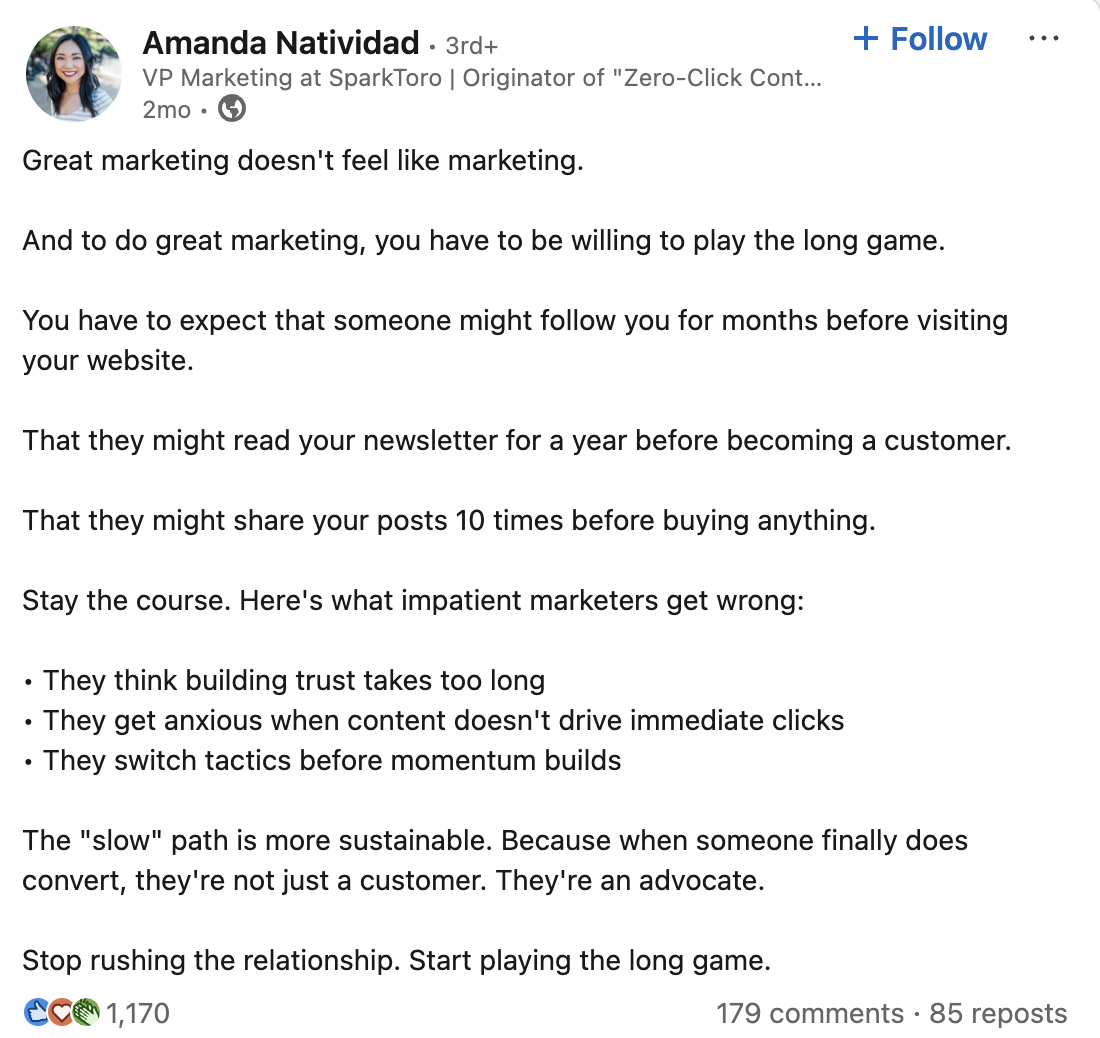
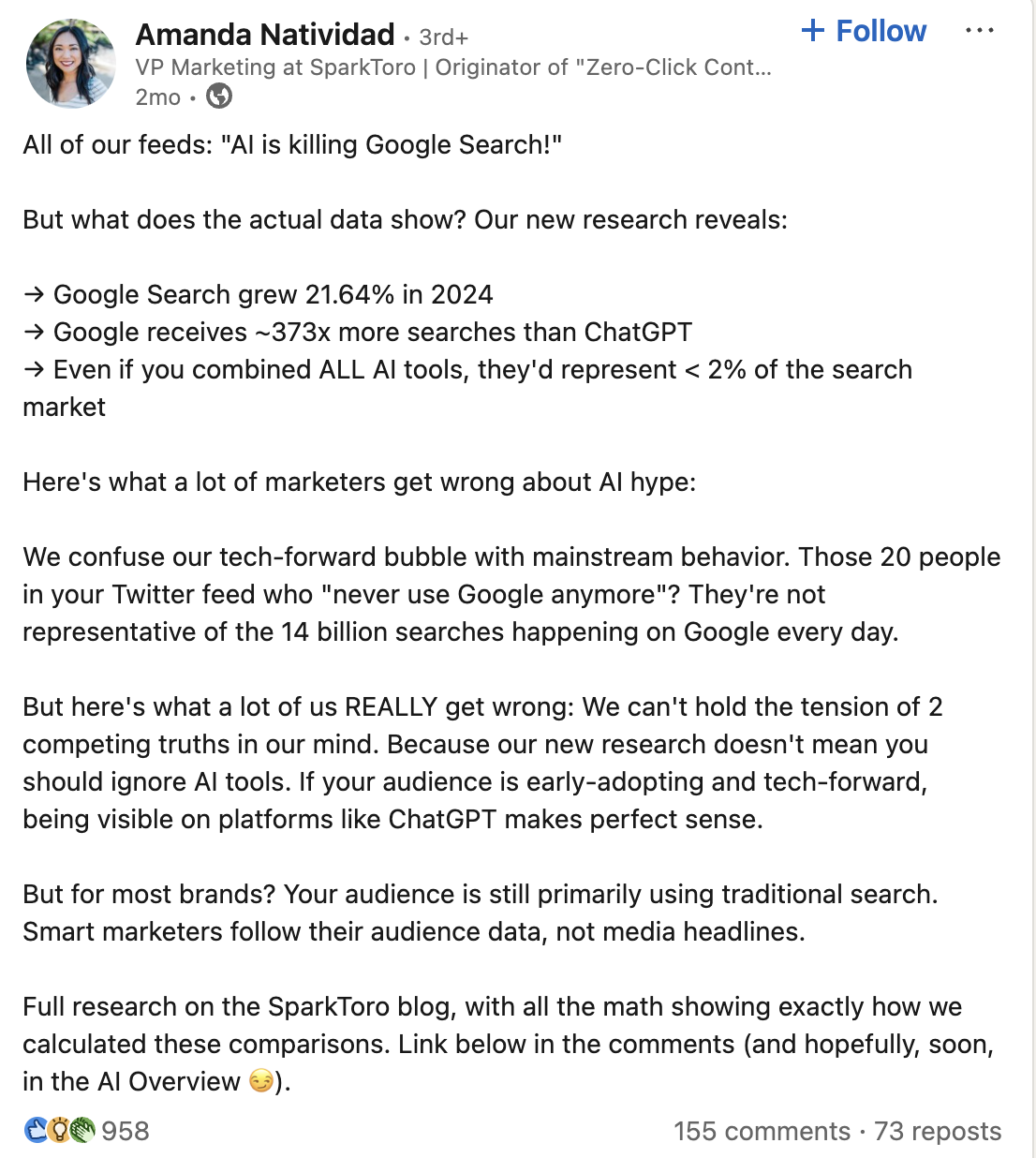
On the other hand, Jacob Klug is wildly successful giving away blueprints of cool projects they’re working on. Here are two of his top performing posts:

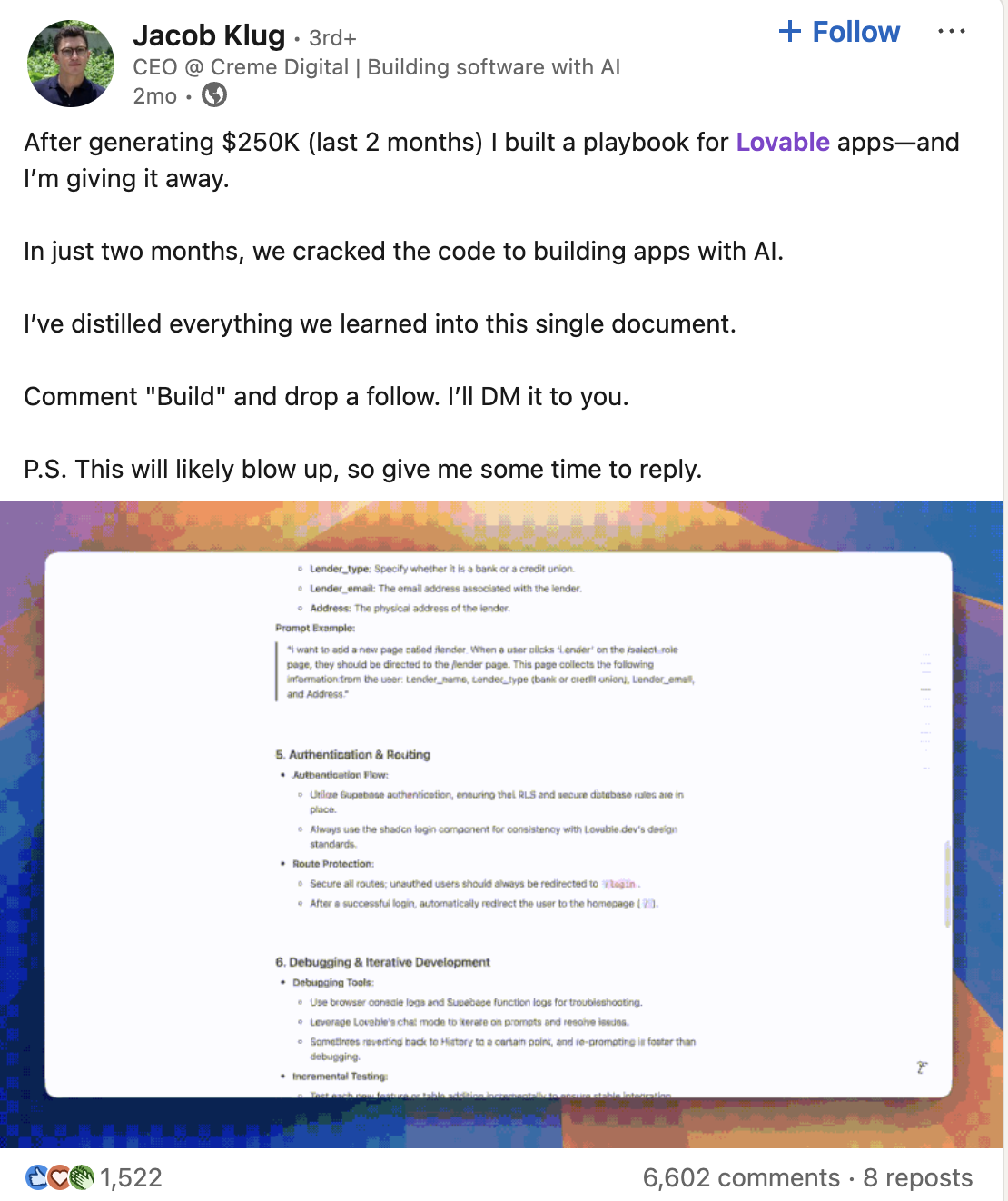
I’ll give you one more example. Two of Gina Sapien’s top performing posts are just lists of companies to work for:
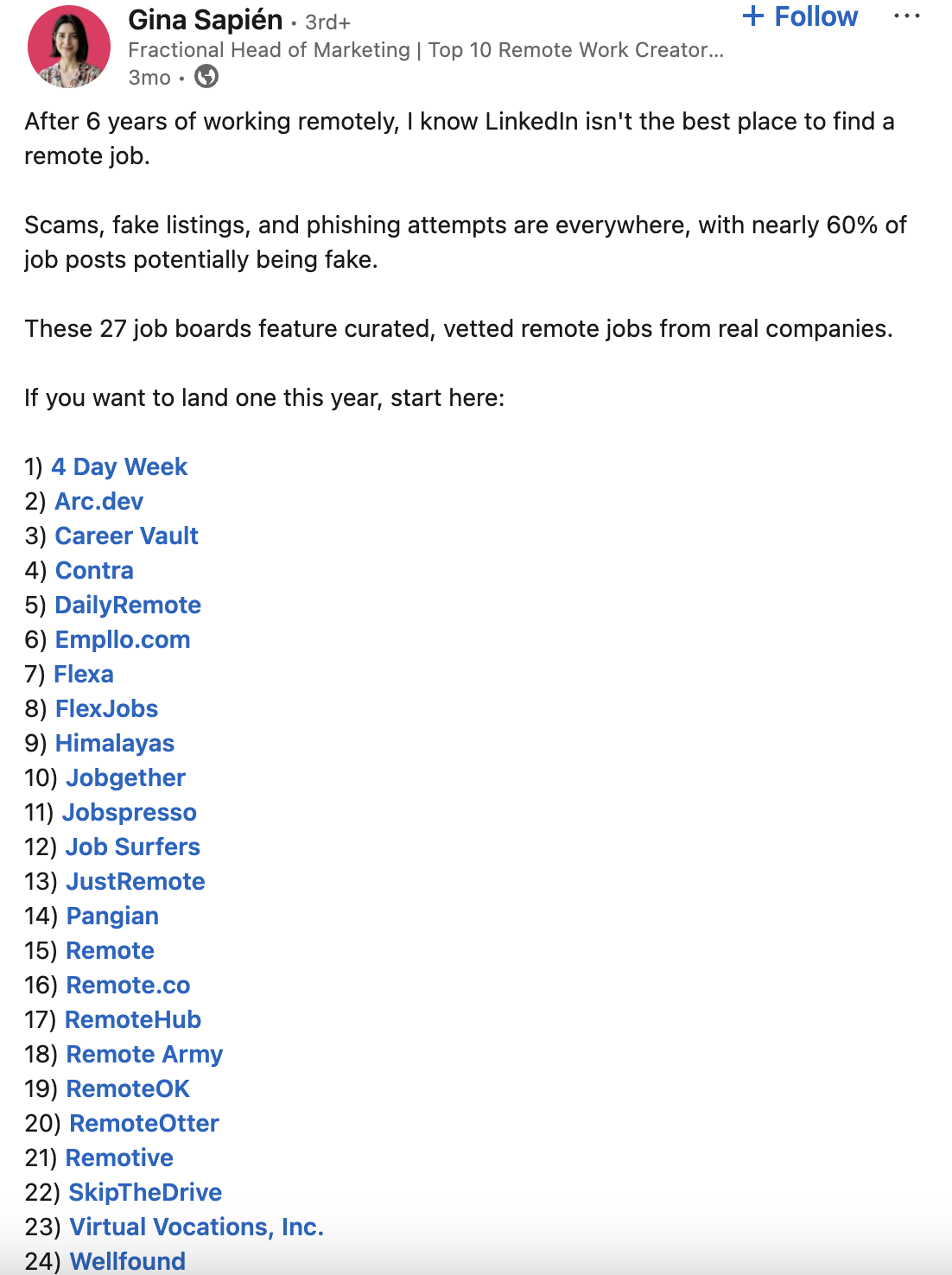
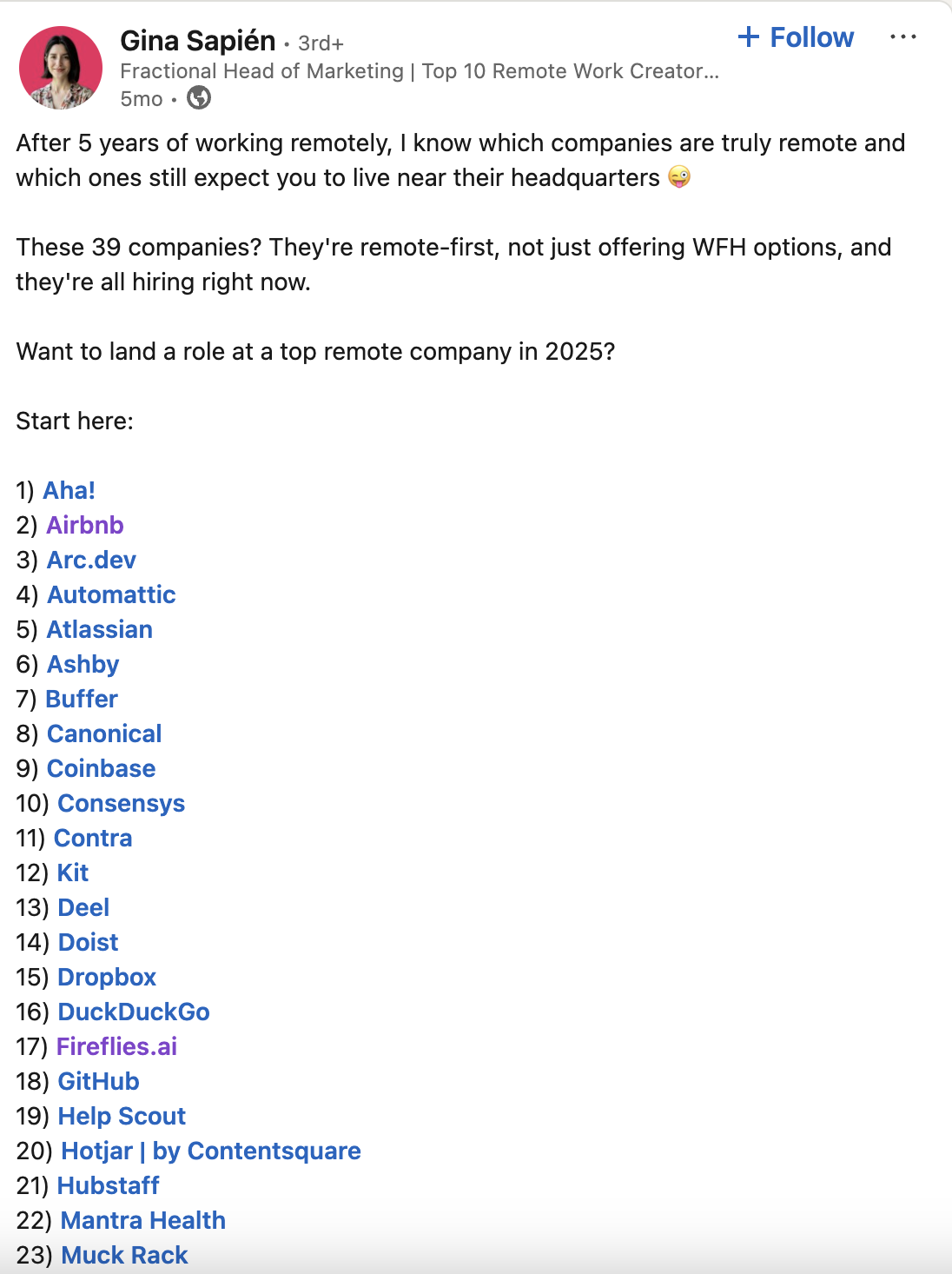
The redundant nature of the top performing posts is likely because each creator found a style of content they were good at creating.
So don’t try to just copy a single creator’s content style. There are hundreds of post formats that can work, so experiment until you find one that you enjoy creating.
However, it’s a good idea to eventually develop a regular content format and style, not just to make the content creation process easier for you, but also because your audience will likely gravitate towards a particular style of content.
If you keep changing the style of content (e.g., super tactical to “feel good” wellness content), you’ll probably see low engagement rates as not all of your audience will like the diverse range of content.
#2: Engagement does not account for follower or relationship quality
Controversial posts and even general mental wellness posts tend to perform very well, but they won’t necessarily help you build a following of prospects.
For example, this post generated a lot of engagement. But did it actually help this person generate revenue? Probably not.
Sure, you can sprinkle in a few posts like this to help increase total reach and allow your followers to get to know you, but it likely won’t demonstrate your industry authority to prospects, meaning it probably won’t help you build revenue.
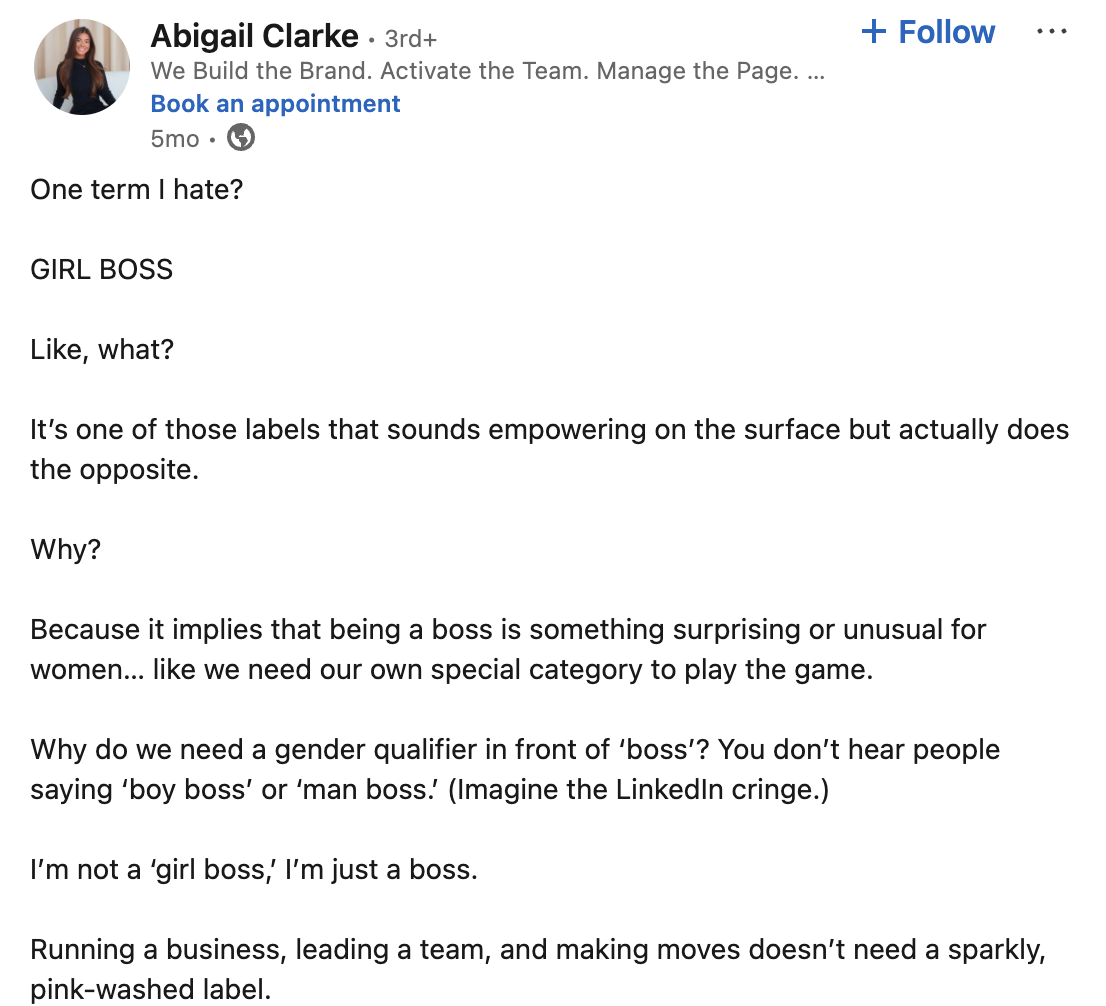
Get More Help Growing Your Personal Brand
Perhaps the most important takeaway from this lesson is that the most important thing to do is to simply post more content.
However, it can be lonely trying to figure out how to improve your personal brand.
That’s why we created Copyblogger Academy. It’s a course and community for entrepreneurs and side hustlers building online businesses. There are courses covering SEO, content marketing, email marketing, personal branding, and other marketing skills that can help you grow faster.
You’ll also have the opportunity to connect with other likeminded individuals in the community, attend accountability sessions, and ask seven figure entrepreneurs (myself and my partner Charles Miller) specific questions.